This post may contain affiliate links. When you click an affiliate link, we may earn a small commission on qualifying purchases, at no extra cost to you. Also, please check for opening times, restrictions, weather, etc., on the days of your trip. We do our best to keep the post updated, but these things can change quickly.
If you love a medieval European vibe, then Bruges is definitely something you will love. It is a cozy, charming, unique city unlike any other European city. It is a place where time seems to stand still, and the very essence of enchantments fills the air.
Bruges is a beautiful place to visit any time of the year. But, especially during fall and winter, it turns into a magical land. With its winding canals, cobblestone streets, and medieval architecture that whispers secrets of centuries past, Bruges is a place where every moment feels like a romantic reverie.
As you walk down the narrow century-old bridges with majestic white swans gliding in the canals nearby, it is easy to feel the romance in the air around you. It is a place I always look forward to visiting time and again.
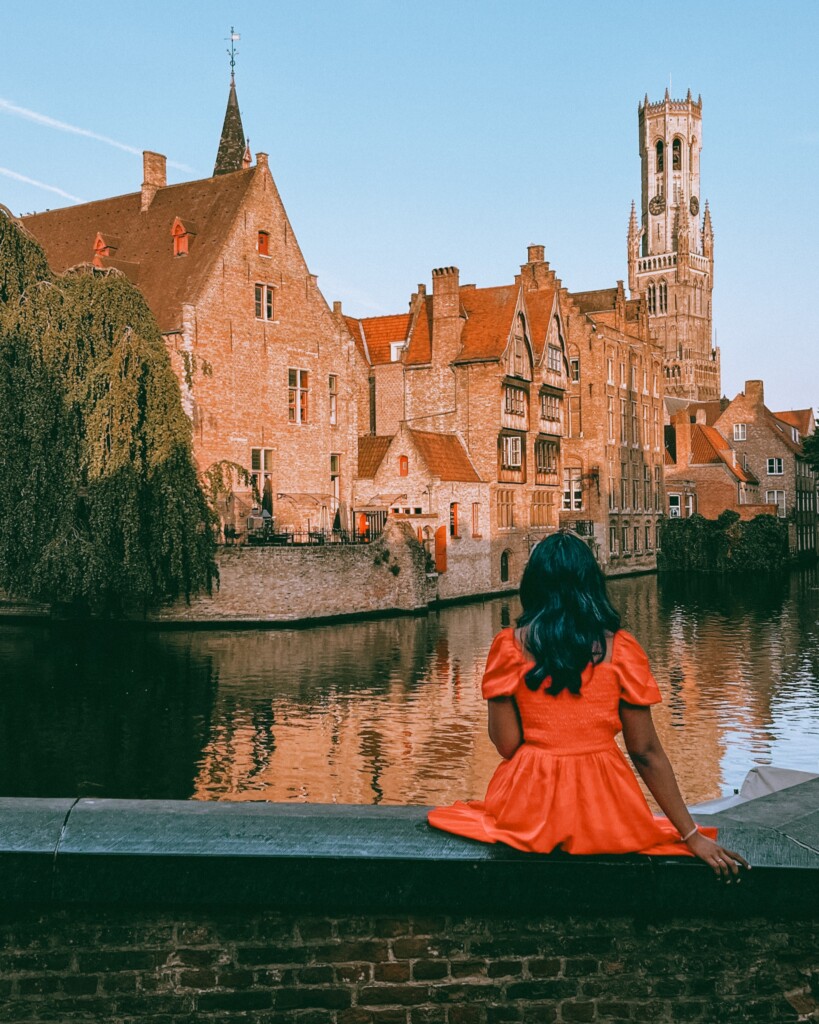
If you are visiting Bruges for the first time, you will probably find yourself lost not just in its beauty but also in its narrow streets, each more beautiful than the other. The first time I visited Bruges, I had no plan and just followed my heart and mostly legs. It was a wonderful experience, and since the historic center is very compact, I didn’t think I would have missed seeing something important.
At least then, it looked to me like I saw them all. Only later did I realize that I missed so many beautiful spots that were very close to the other places I visited, but I just didn’t know that I had to look for them in the first place. The next time, I visited everything I missed and compiled a complete list of all you can see in Bruges.

How to Reach Bruges?
Bruges is well connected through trains from both Antwerp and Brussels, two main cities in Belgium. It will take around 1.5 to 2 hours to reach Bruges from Antwerp, with a change in Gent. It takes about 1.5 hours from Brussels North without any transfers. You can also quickly drive to Bruges, but I recommend going by public transport to explore the city.
How Many Days to Spend in Bruges?
Bruges is a magical city, and I recommend spending at least 2 days minimum. However, a lot of tourists visit the city on a day trip. 2-3 days would be an ideal time to explore the city and climb Belfry or visit some museums or cathedrals based on your interest.
I would not recommend visiting Bruges as part of a day trip for many reasons. The main reason is you will be stuck among the many tourists visiting the city and won’t be able to enjoy its magic. Spending a night or two will give you sufficient time for the city’s charm to rub on you and do its magic. (It could sound like I’m hyping the city up, but it is what it is.)
When to Visit Bruges?
Bruges is a fabulous place to visit any time of the year. However, spring and summer are usually more overcrowded than other seasons. But also Christmas time is quite popular because of its charming Christmas markets. If you want to enjoy peace and quiet, fall and winter (except during the holiday season) are perfect as the crowds are comparatively less. I especially love visiting during the fall to enjoy the foliage colors, which add to the magic of the place.
Why Go on a Self-Guided Walking Tour in Bruges?
The best way to explore Bruges is by walking, and trust me, you don’t want to drive around the old town. Not only is it difficult (and sometimes not allowed), but it is also not the best way to experience the city’s magic.
We loved our experience walking around the city several times and have created this ultimate self-guided walking route for you to enjoy your time in Bruges. Oh yeah! We have included a nice map marking all the places for you to start using it right away, hassle-free. For convenience, we have made the entire route in a loop so you can start with any location closer to your stay. You need not travel far to just begin your walking tour. I have also added some tips and photo spots to help you plan your perfect trip.
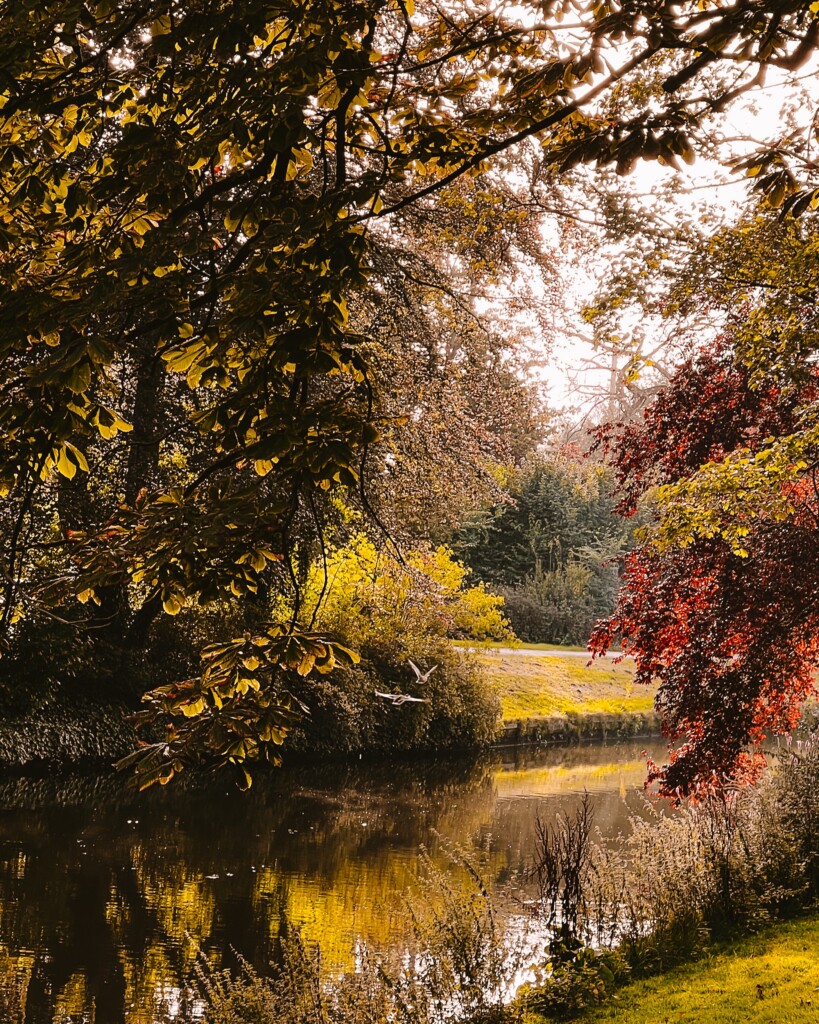
Tip! Although this is a walking tour guide, I highly recommend taking your time at each stop and visiting places on the way. You can do this entire route in a couple of hours or take two days to explore more at your favorite stops and immerse yourself in the city’s vibe. Also, Belgium is famous for its chocolate, waffles, fries, and beer, and it would be such a disappointment not to load yourself with all these delicacies. Their waffles are to die for.
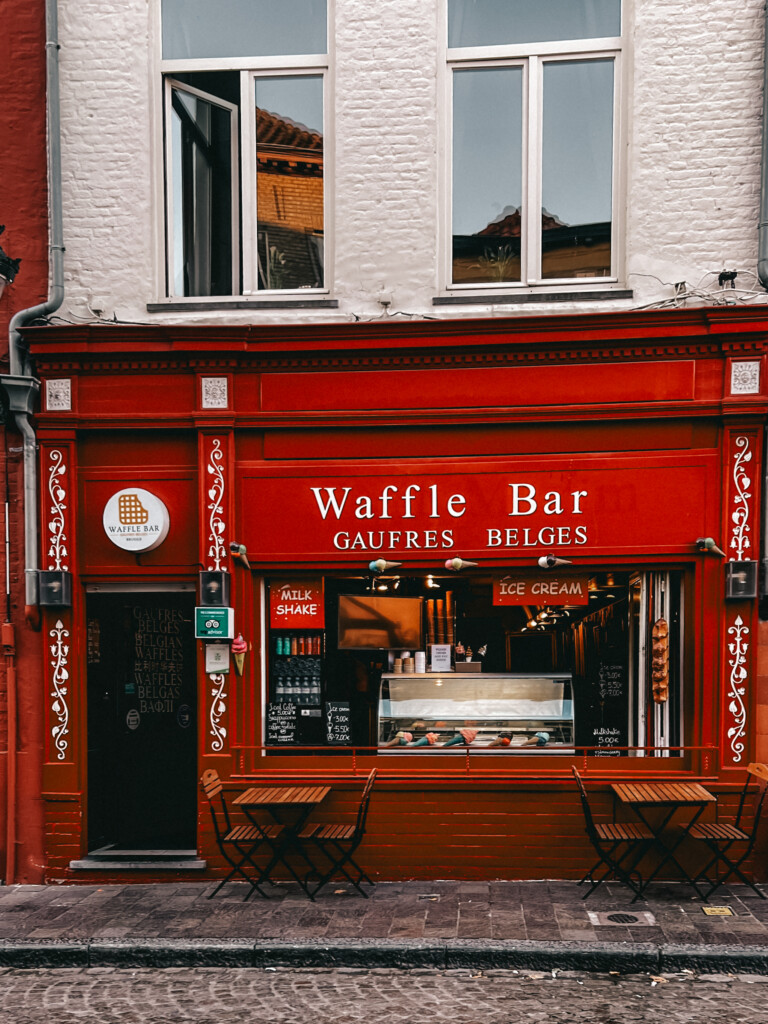
The Walking Route
It’s time to put on your walking shoes and get transported to the medieval era.
Since the best way to reach Bruges is by train, which has connectivity from Brussels and Antwerp, the two main cities of Belgium, for convenience, I have the main railway station of Bruges as the starting and ending points of our walking route. If you happen to commence your walking tour from a different location, feel free to bypass the station and proceed to the subsequent stop, as the Bruges railway station, unlike some beautiful railway stations in Europe, holds little allure and makes no sense to visit unless you are hopping on a train.
How To Use The Map?
The locations from the walking route are numbered in the map. If required, zoom in and click on a number to view brief details about the location. Click ‘View in Google Maps’ to view the location’s complete details in Google Maps.
1. Minnewater Park and the Lake of Love
Minnewater Park, located right across the station, surrounds a beautiful lake called the Lake of Love. This place is actually as mesmerizing and romantic as it sounds. Bruges is known for its rich and dark medieval history, and there is a legend about the lake getting its name from a romantic story with a rather heavy ending.
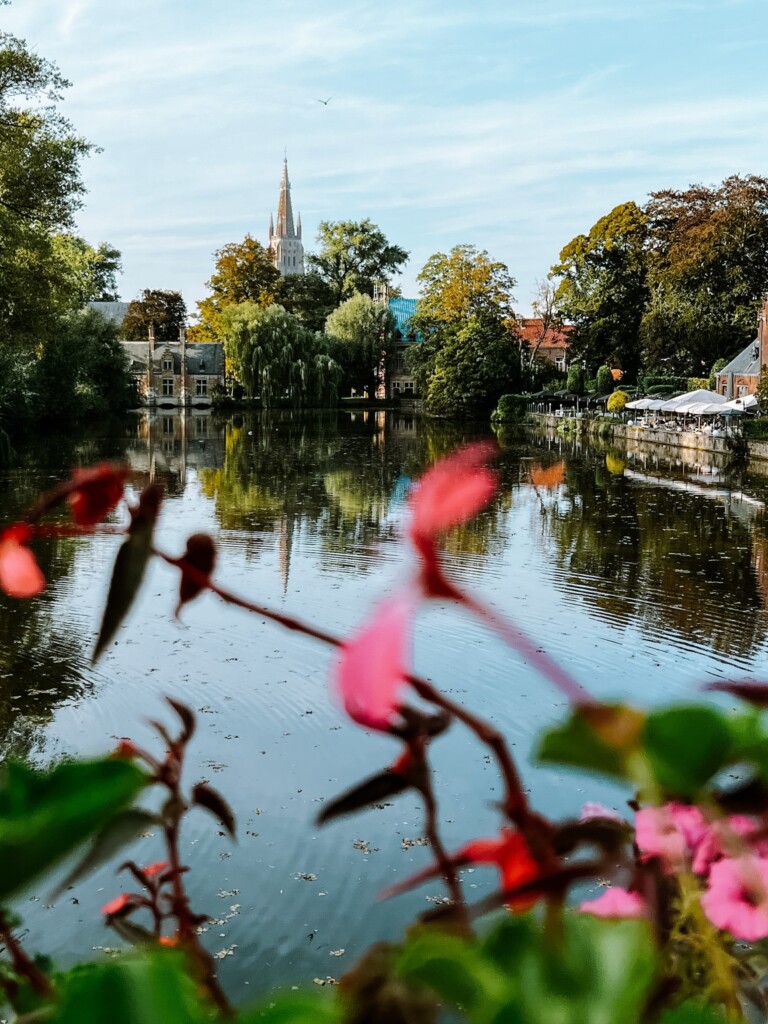
Nevertheless, the park looks so serene, and you would forget that you are in the city’s heart as it feels so magical. The park is huge, and you can spend a lot of time sitting by the lake or walking around the park.
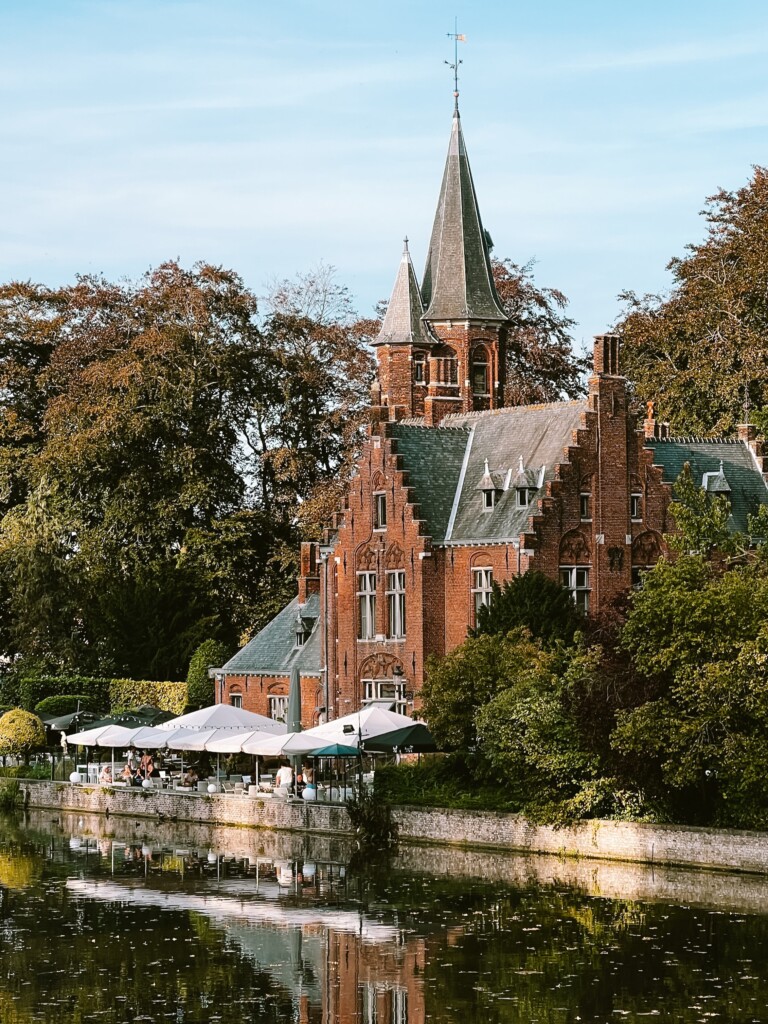
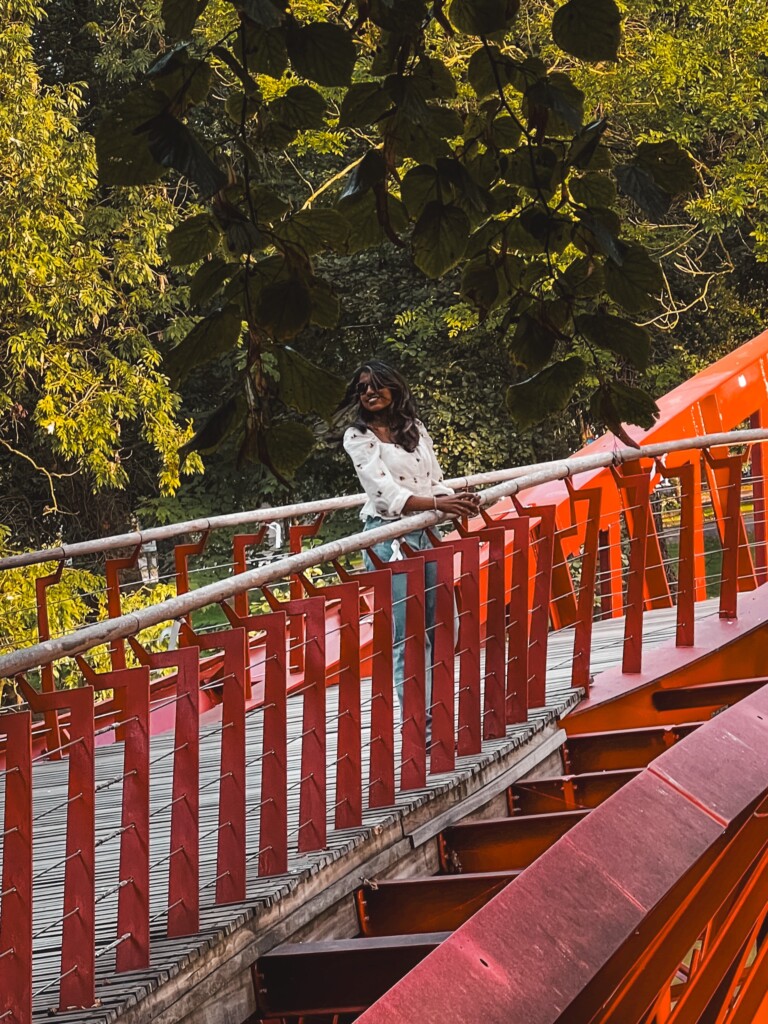
But here are some things that are not to be missed if you don’t have too much time.
- The bridge across the lake is called the Minnewaterbrug, also called the Lover’s Bridge, and it is believed that kissing your partner on the bridge will seal a lifelong love.
- There is another red bridge a little further along after crossing the Lover’s Bridge called the Barge Bridge, which is a beautiful photo spot.
- When crossing the Minnewater Bridge, you can already spot the Minnewater Castle on the other side of the lake. The Minnewater Castle is now a restaurant, but it looks more beautiful from the other side of the lake.
Oh, did I mention swans? You can see many of them gracefully gliding across the waters, making you feel like you have been transported to a fairytale land.
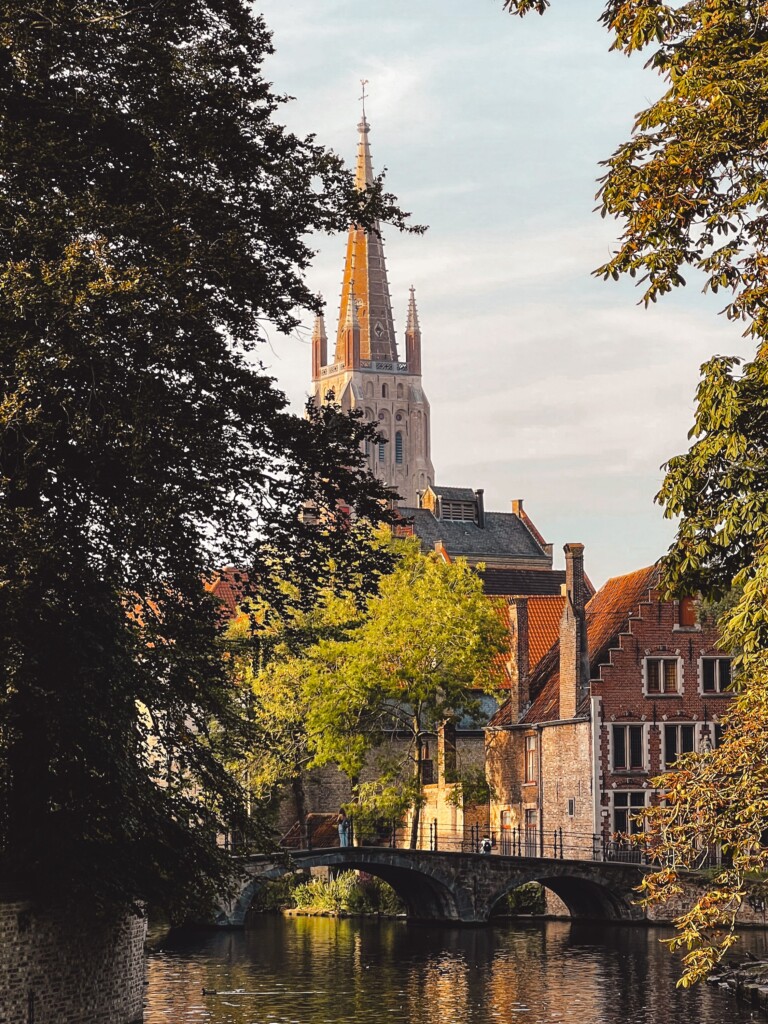
Route Guide
The next stop is just around 500 meters from the Barge bridge and a 7-minute walk through the Minnewater park.
2. Begijnhof
The Begijnhof of Bruges is part of the historical center of Bruges, a UNESCO World Heritage site. The Begijnhof, founded in the 13th century, was home to a group of women known as Beguines, who were not nuns but chose to live a life dedicated to prayer, charity, and community service. The Begijnhof comprises a set of white-washed houses that reflect the Flemish Architecture and has a small church and a central green courtyard.
Begijnhof was quite unique in the medieval period, allowing women to follow religion and community service without taking formal religious vows.
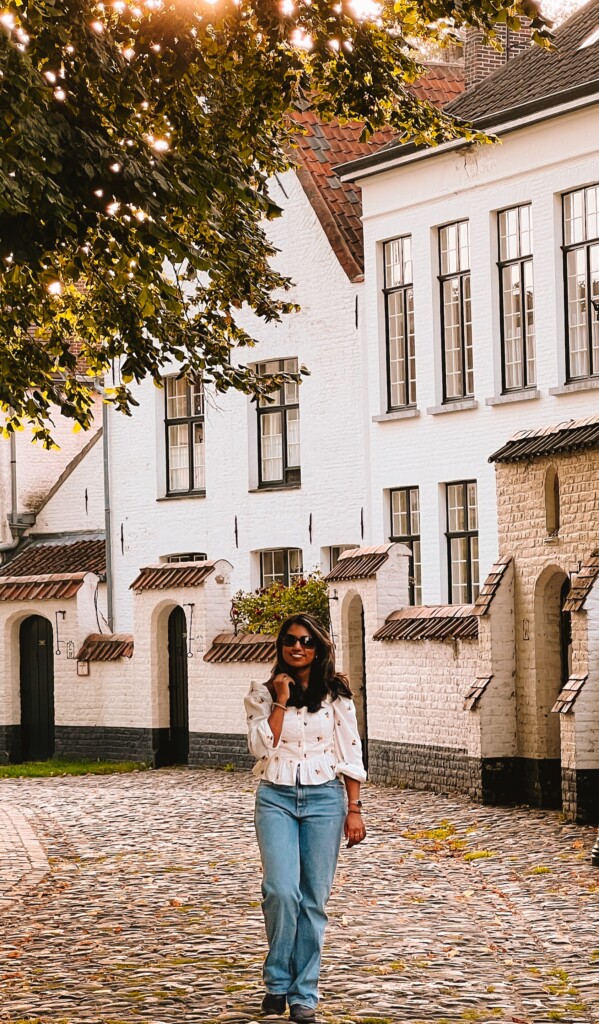
This place looks picturesque and serene and holds a lot of significance during the religious and political turmoil of the Middle Ages. This place also served as a shelter for the poor and the vulnerable during the various crises that happened during the time.

Currently, these houses are residences of Benedictine nuns who maintain the place’s serene environment and religious traditions.
Tip! On the way to Begijnhof, check out Sashuis, which is very close to Begijnhof, and it looks like a house built on top of the canal. Sashuis was once the lock house and residence of the lock keeper of the canal. Currently, it is also used as a center for exhibiting local artisans’ works. So, if you are into handmade works, drop in and check out the beautiful work of the local craftsman.
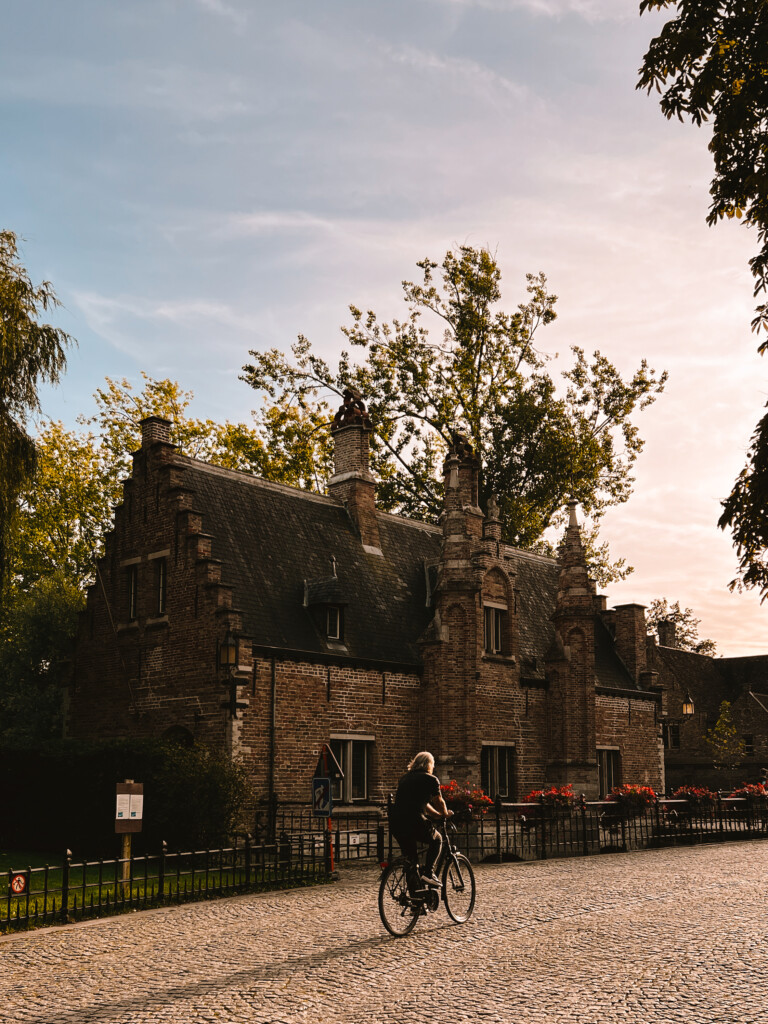
Photo Spot
If you walk along this place during the evenings, you can see all the swans gathered around in the canal and in the green patch along the canal where they eat. It is such a lovely sight to see so many swans at once.
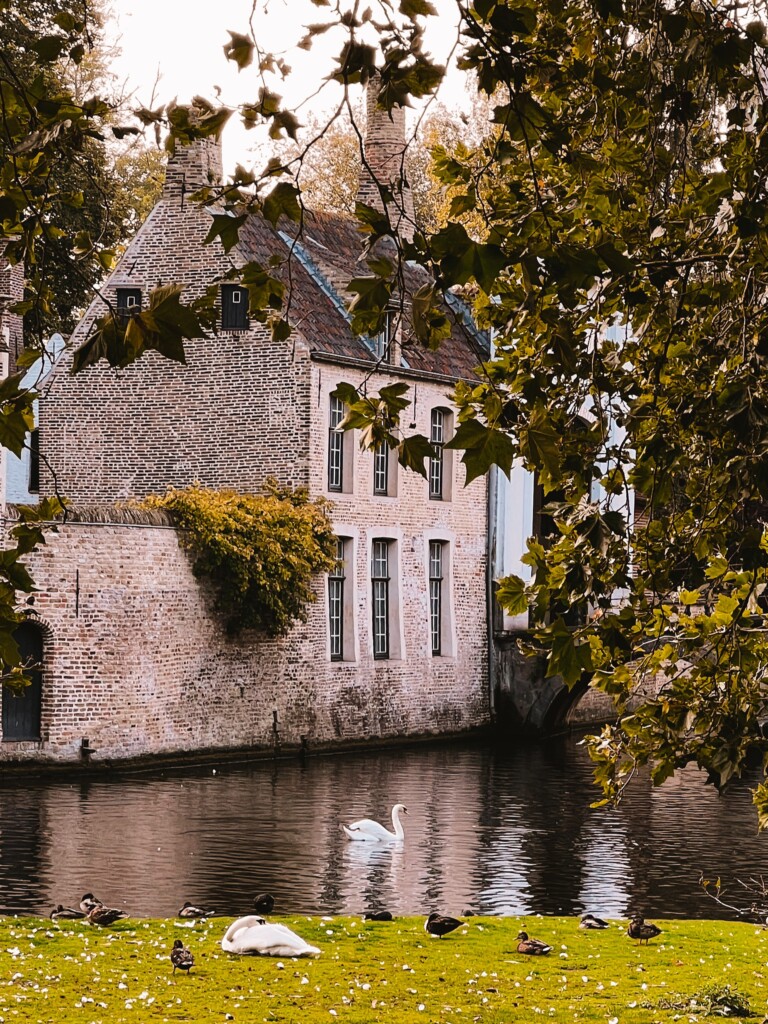
Route Guide
The next stop is around 500m from the Begijnhof. But, when you are walking along Wijngaardstraat, you can spot all the horse carriages. I love the “clip-clop” sound that comes as the horses walk. It really feels like you are in a different era. However, watch out for horse poop when you walk down this street. I found this place to be a little smelly (if you know what I mean), but it is beautiful to see these carriages. (There is even a horse-head-shaped water fountain on this street.)
3. Sint-Janshospitaal (Saint John’s Hospital)
Saint John’s Hospital is one of the oldest surviving hospitals in the history of Europe. This hospital, built in the 12th century, started as a hospice for pilgrims and travelers and later converted to a hospital. It provided medical care for around 800 years until it was closed for service in the early 20th century. It was then converted into a museum to showcase the history of healthcare and medical practices throughout the centuries.
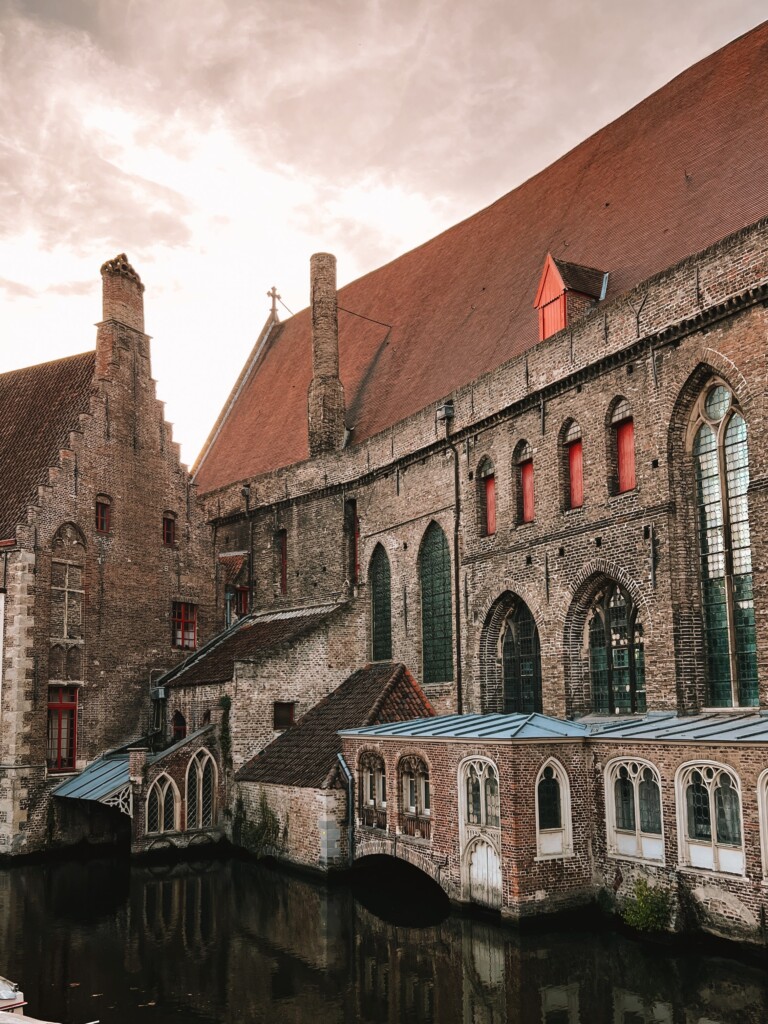
Note! The museum is temporarily closed for visitors and reopens on 16th December 2023.
Photo Spot
The view of Saint John’s Hospital from the Mary’s Bridge (Mariabrug) is quite beautiful. It offers a nice spot to capture the architectural beauty of the place. You will go through this path if you also take a canal tour, giving a different perspective from the waters.
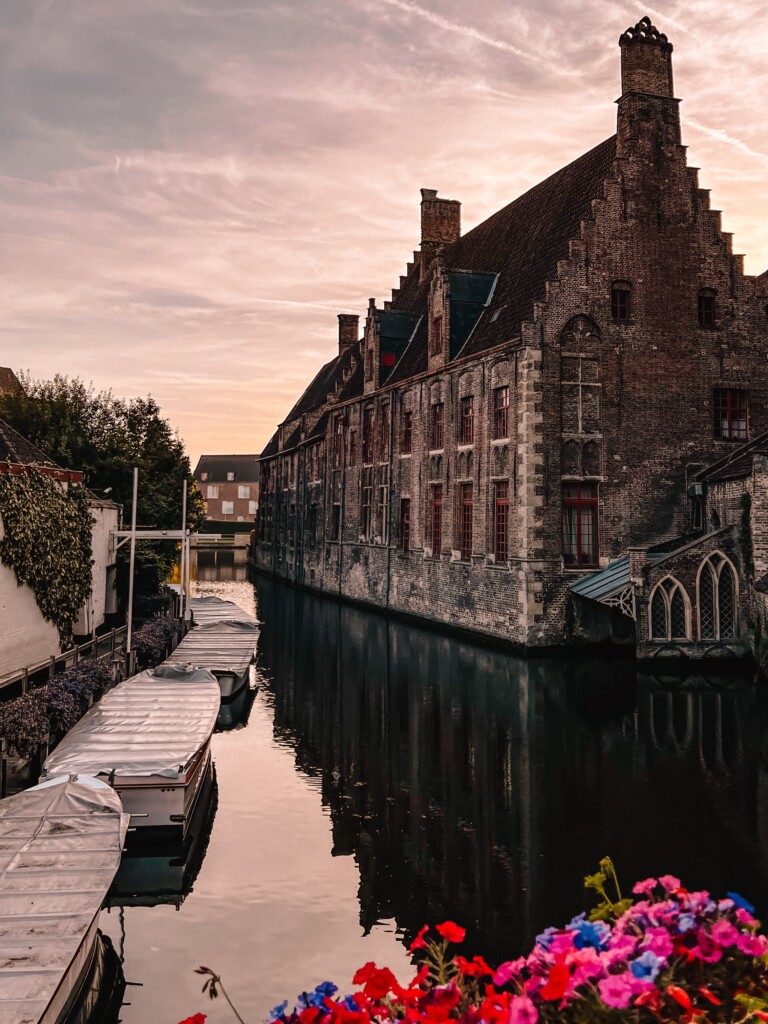
Route Guide
The next stop is next to Saint John’s Hospital, just 50 meters away (can’t be any closer, I suppose).
4. Onze-Lieve-Vrouwekerk (The Church of Our Lady)
The construction of this brick church started in the 13th century and displays a combination of Romanesque and Gothic styles. The soaring tower of this church stands at an impressive height of 115 meters, making it the second-tallest brick tower in the world. (Isn’t that spectacular?)
This church spire adorns the skyline of Bruges beautifully. The church is open to visitors and houses a museum but continues to be an active place of worship.
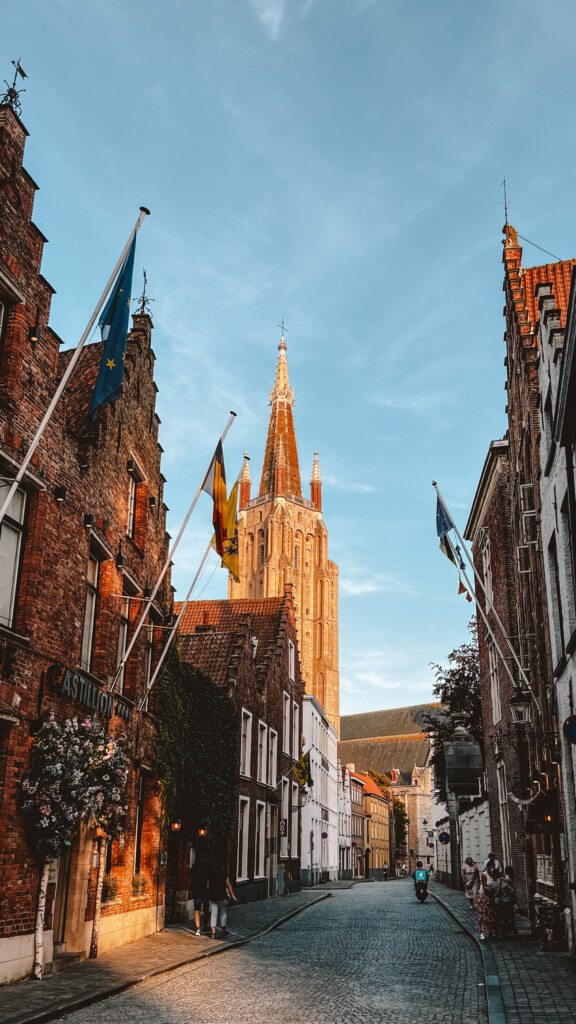
One of the noteworthy pieces in the museum is the sculpture of “Madonna and Child” by the renowned Italian Renaissance artist Michelangelo. It is one of the very few of his works that can be found outside Italy.
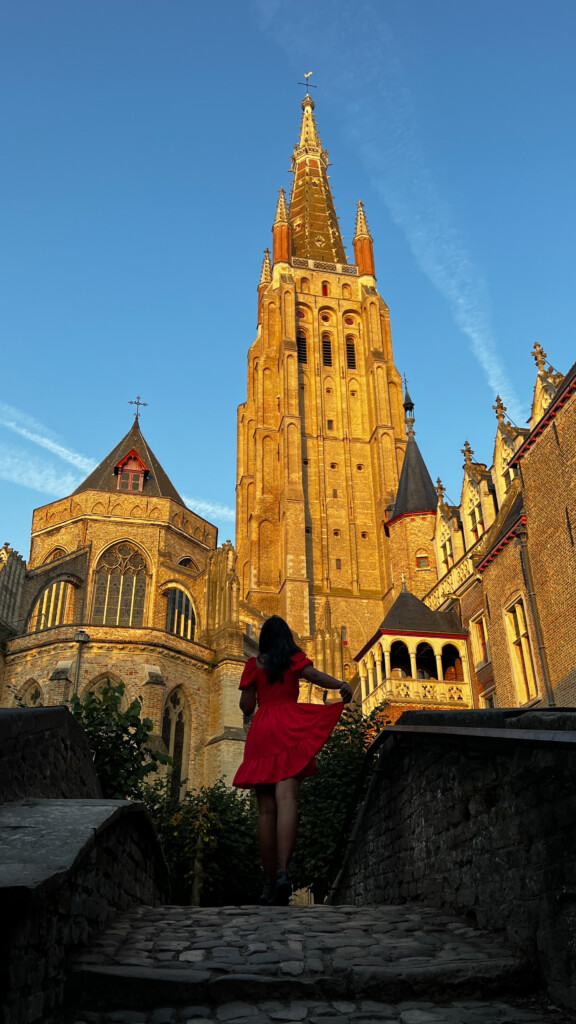
Route Guide
The next stop is around 210 meters from the church and takes about 3 minutes.
5. Bonifaciusbrug (Boniface Bridge)
Boniface Bridge, a very old one, is one of the newer constructions in the city around the early 20th century. But it is one of the most popular and beautiful bridges in Bruges, mainly owing to the views around it. You can gaze at the half-timbered houses hanging over the canal, which looks much more romantic when a group of swans pass by. The bridge also offers a nice view of The Church of Our Lady and its spectacularly high towers. You could also peek at Gruuthuse Museum, right behind the bridge.

Photo Spot
This bridge is one of the most popular photo spots in the city, and you can see why. It sure looks stunning at any hour of the day. Still, the morning lights paint this place in golden light, which looks exceptionally picturesque.

If you get lucky, you can spot a bevy of swans racing each other in the canal waters. It was quite the sight, and it really made me feel proud about waking up early.
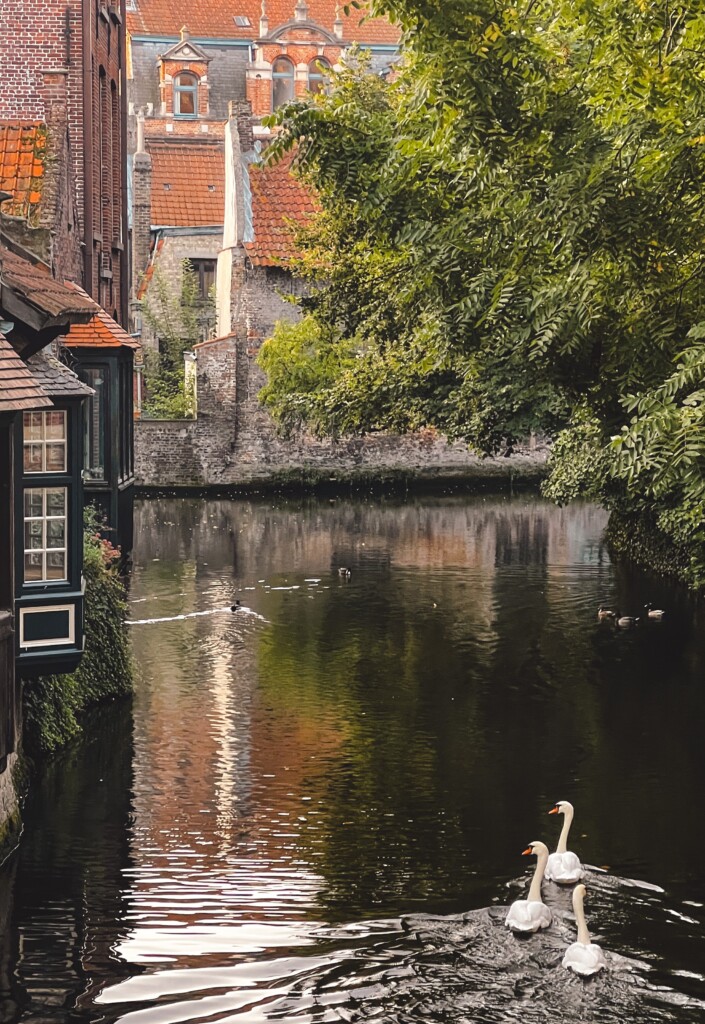
Route Guide
The next stop is just on the other side of the bridge and is just 120 meters away.
6. Gruuthuse Museum
Bruges is famous for its countless museums, from the traditional historical museums to the modern, and there are even some quirky ones to explore. Gruuthuse Museum is a historic gem that offers a deeper insight into the heritage of the city and the region of Flanders. It is worth walking around the museum’s exteriors even if you are not into museums, as it is a former palace turned into a museum. Its late Gothic-style architecture is something to admire, and the courtyard is free to access.
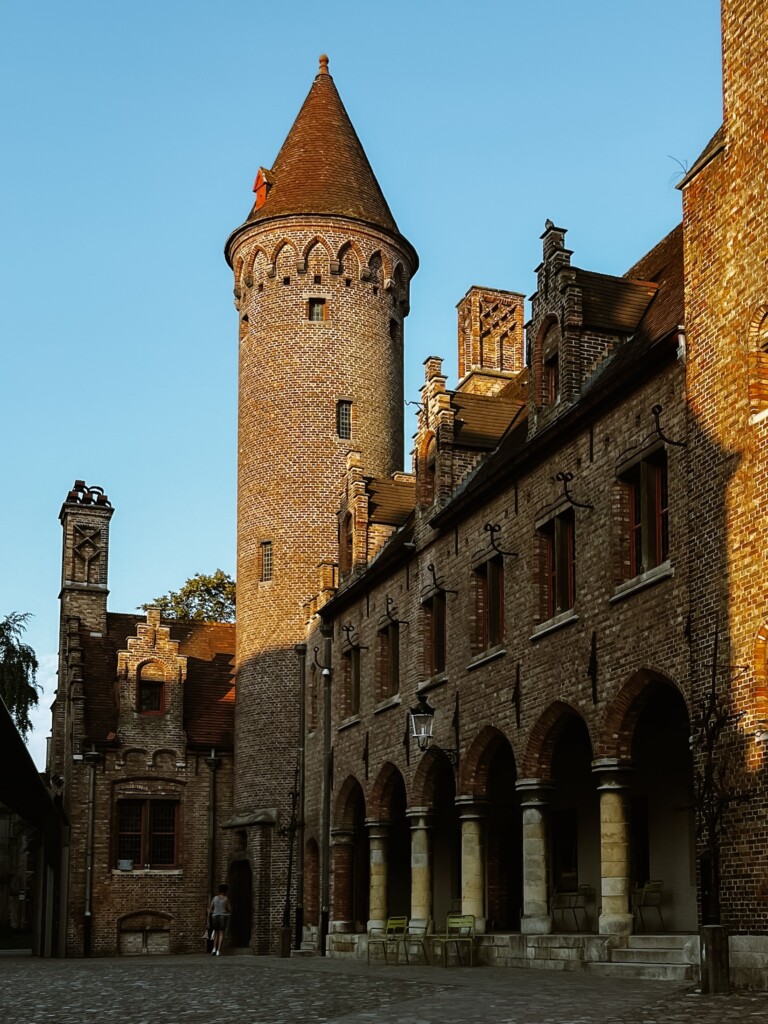
Route Guide
The next stop is right across the road to the museum’s main entrance. It is just 100 meters away along the canal.
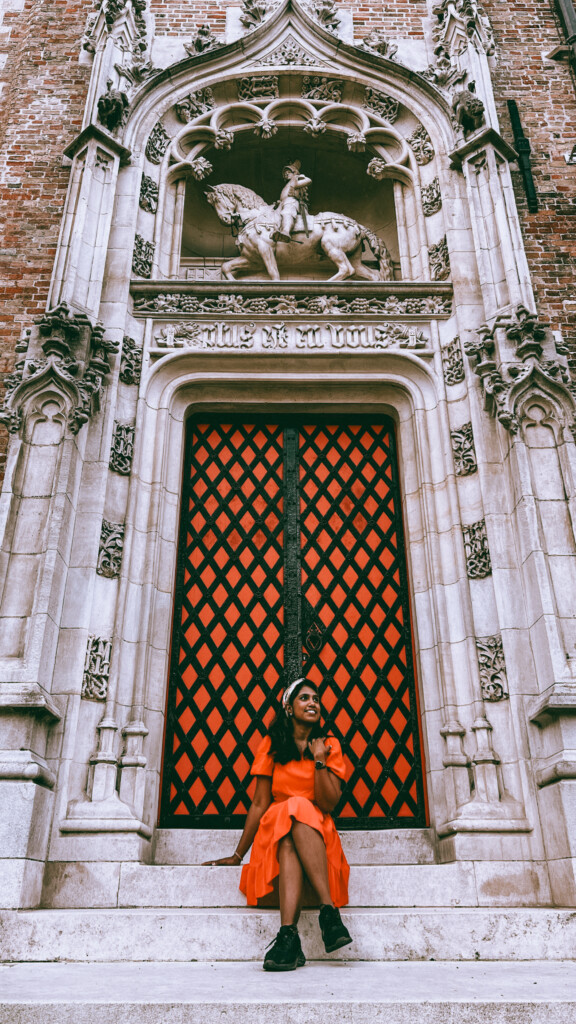
7. De Dijver Park
Although called a park, it is not as big as Minnewater Park or any park in general. You can spot a small stretch of a few rows of trees along the canal. But walking among the trees is pretty nice, especially in fall, as the foliage turns orange, and you can see fallen leaves all along the pathway.
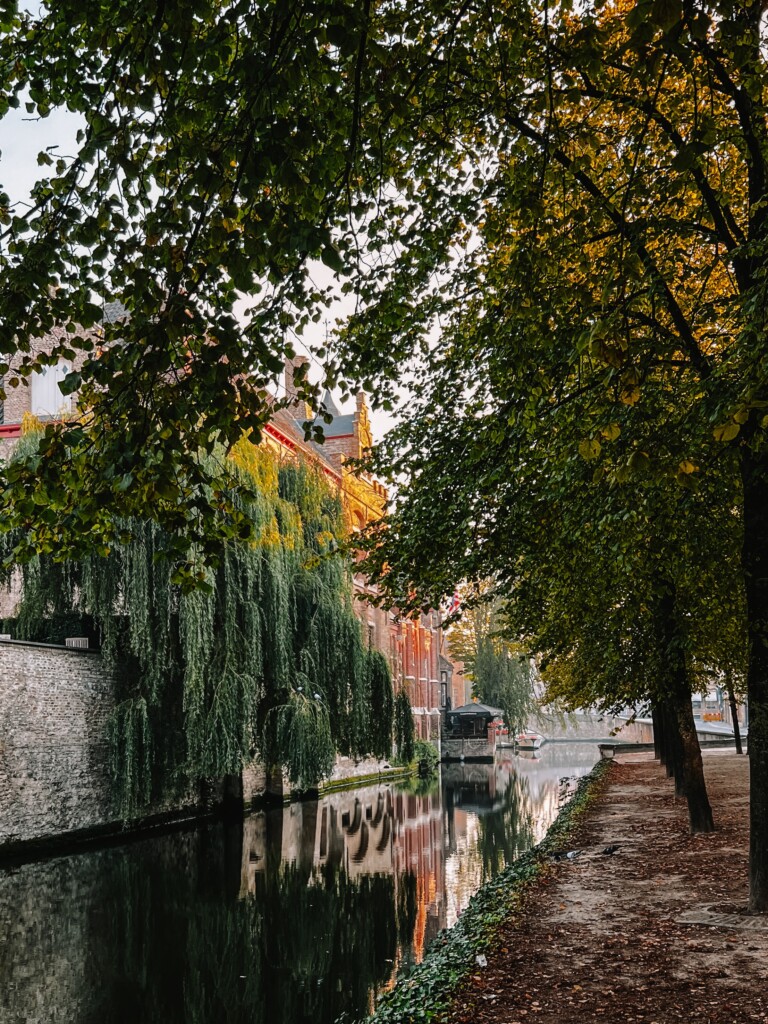
Psst! The locals usually set up flea markets here, and you can see some interesting things for sale.
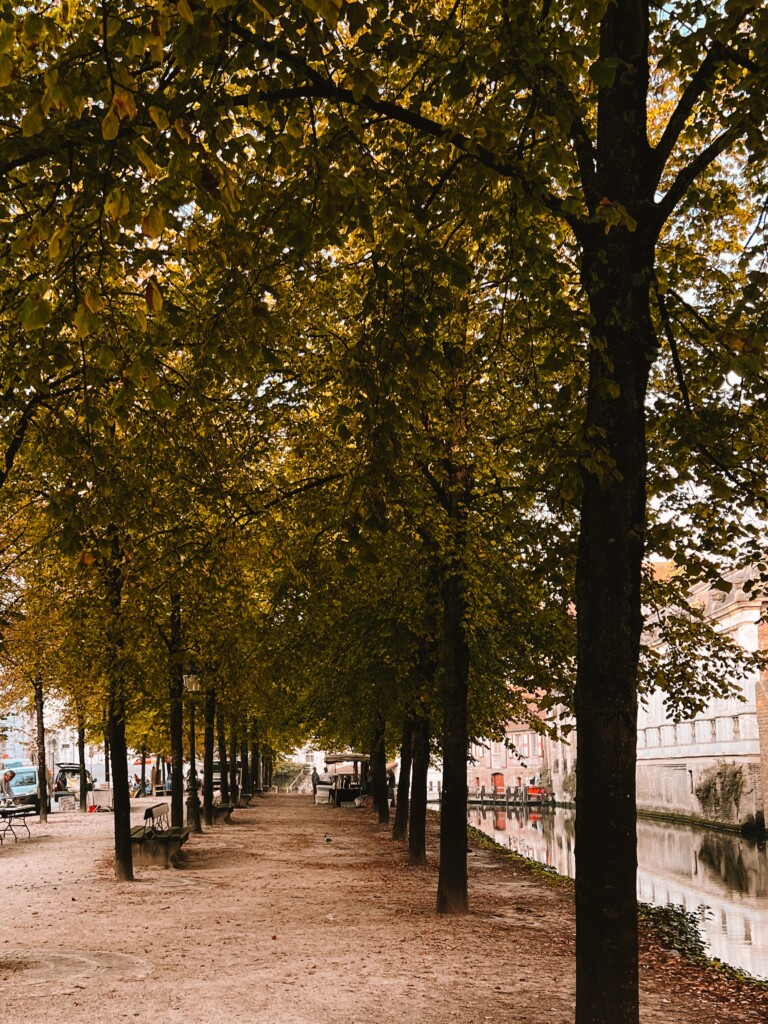
Photo Spot
On the side of the park near the Gruuthuse museum, you can get a good view of the canal, the trees, and the houses, making it quite a nice photo spot.
Route Guide
Spoiler alert! The next stop is a shop, which could be interesting for people of different interests for different reasons. So walk along the trees to the other end of the park and take the turn to your left at Nepomucenusbrug. It is only 240 meters from the farther side of the park. (Yes, it’s that small, but beautiful though.)
8. 2be Shop and the Beer Wall
The 2be shop is a store with many TinTin merchandise and other products. Even if you are not buying, it is lovely to walk around the shop looking at all those cute miniatures from the TinTin series and a few others. They also have a bar and a collection of liquor on display. Before you enter the 2be shop, you can already spot a wall full of various types of beers on display. It is called the Beer Wall, and there is a nice, cozy bar right there.
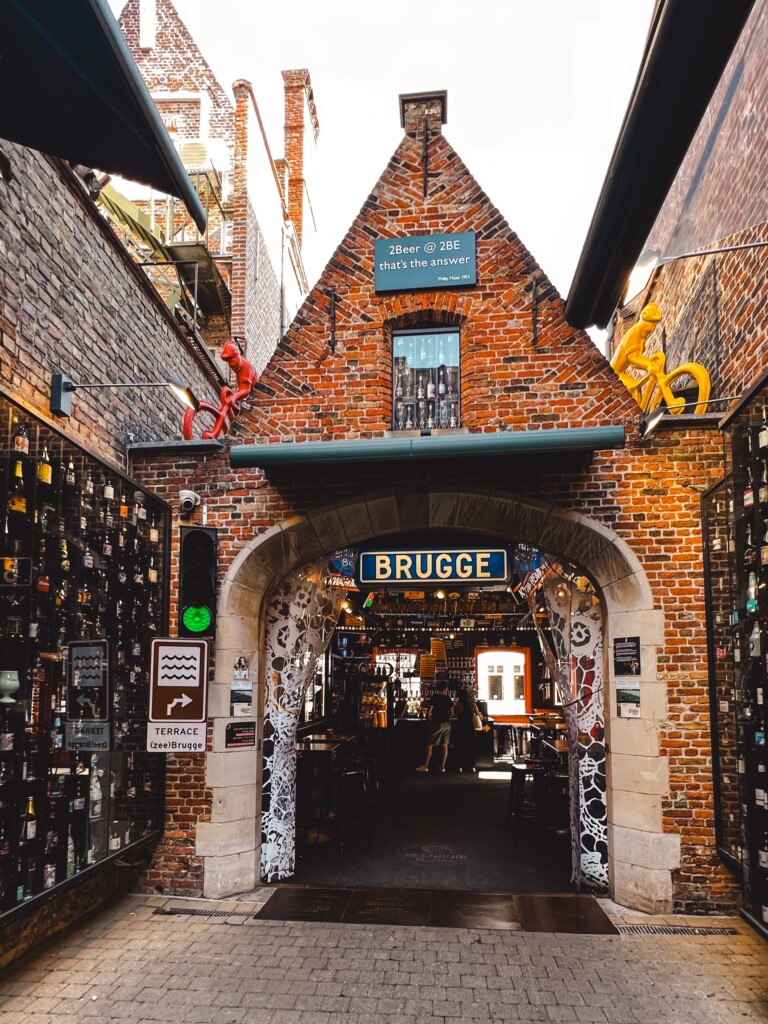
This little shop also has a small terrace from where you can get outside views of the canal, which is quite beautiful. It is a nice place to capture a couple of shots, especially in the mornings and evenings, as the light is more soft for pictures.
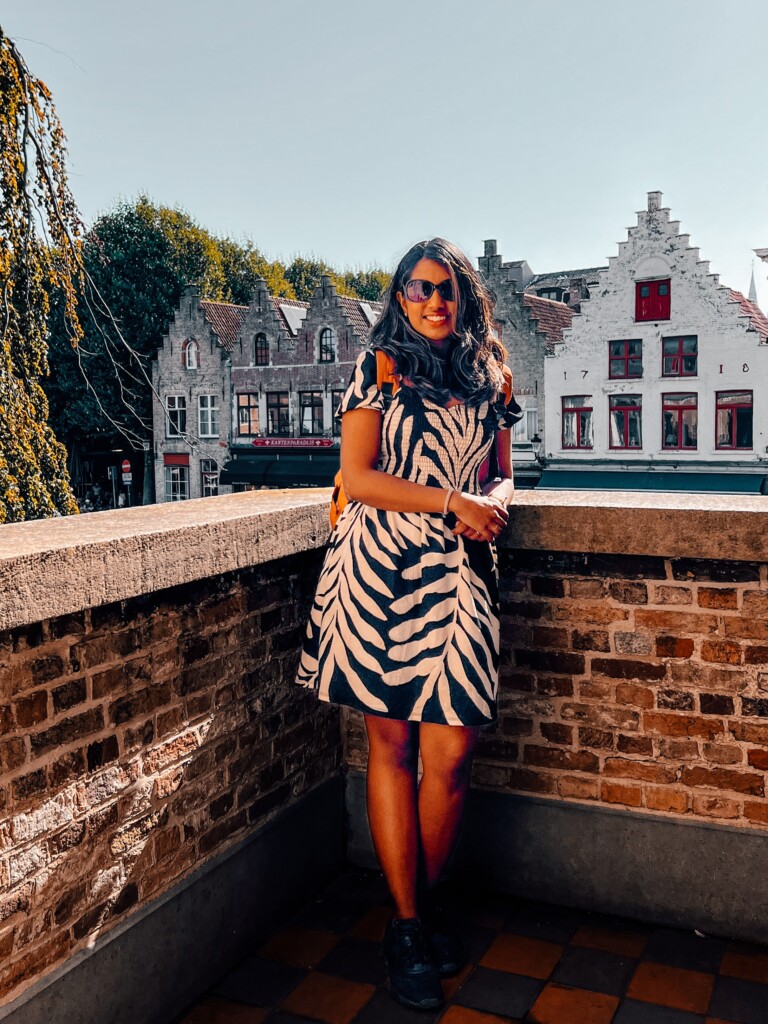
Route Guide
The next stop is again pretty close and only 100 meters away. I know, right? In Bruges, you can see a lot, even walking very little. It is all close together.
9. Rozenhoedkaai
This place is one of the most popular spots among the tourists. It is a super famous Instagram photo spot in Bruges. A little after 10 am, you will slowly start seeing crowds fill this little street, as it is also the starting point for canal tours. Centuries before, rosaries were sold here, hence the name.
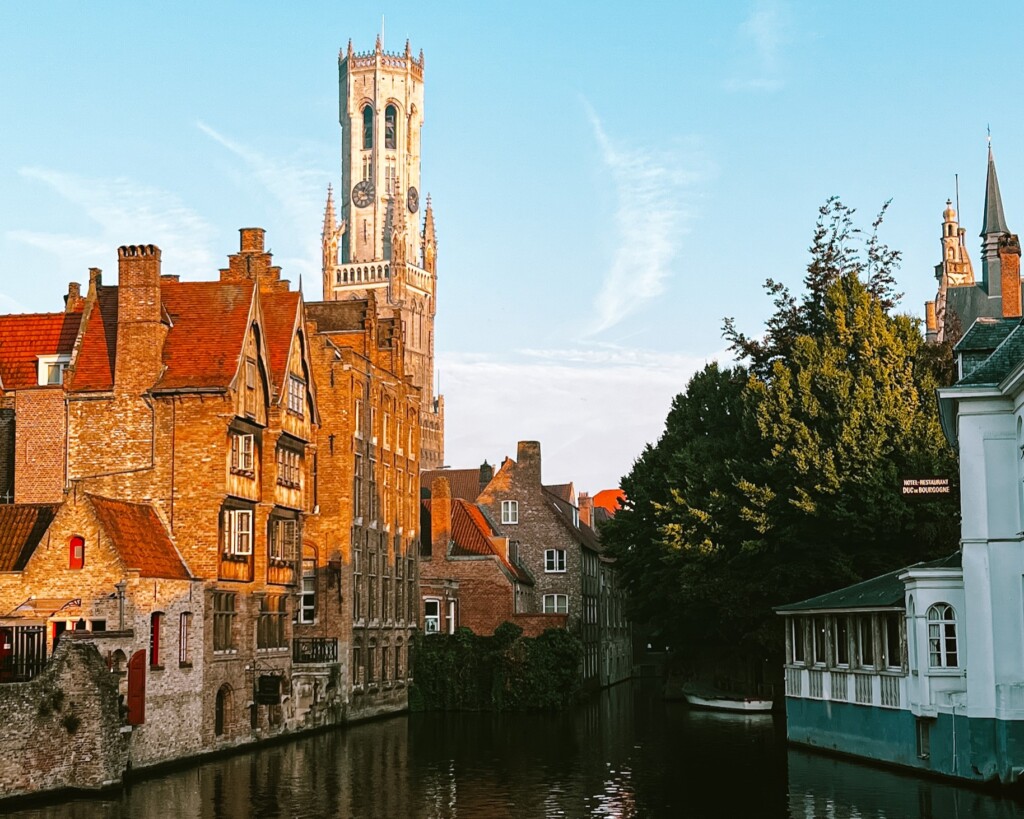
Rozenhoedkaai offers a great view of the Belfry of Bruges with a canal in the foreground. But, it could be really difficult to enjoy the views when it is crowded. If you like to capture some great postcard shots, visit the place before 10 am in the morning when you can admire the true beauty of the place.
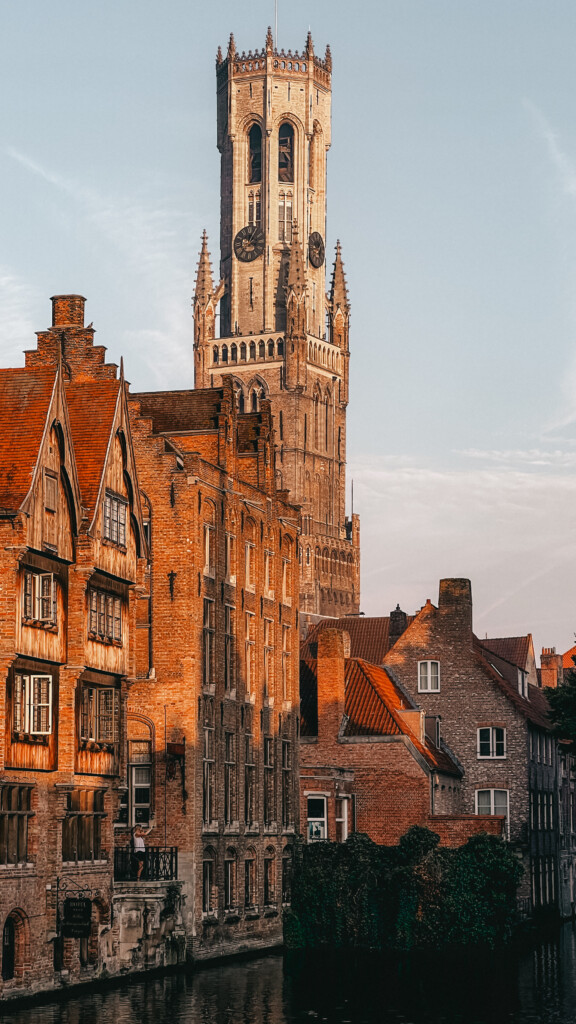
Tip! If you visit during peak hours, just hop on a boat tour, which will still be full, but you can get a better view from the water than from the street level, which is filled with people.
Route Guide
You need to just walk about another 140 meters until you reach the next stop.
10. Blinde-Ezelstraat
Blinde-Ezelstraat is a narrow, short street connecting the fish market (Vismarkt) with Burg Square. There are many interesting legends to explain the reason behind the name of this street, which means Blind Donkey Street. However, the actual reason might not be that interesting, as the street got its name from just an inn from the 15th century called Den Blinden Ezel (The Blind Donkey).
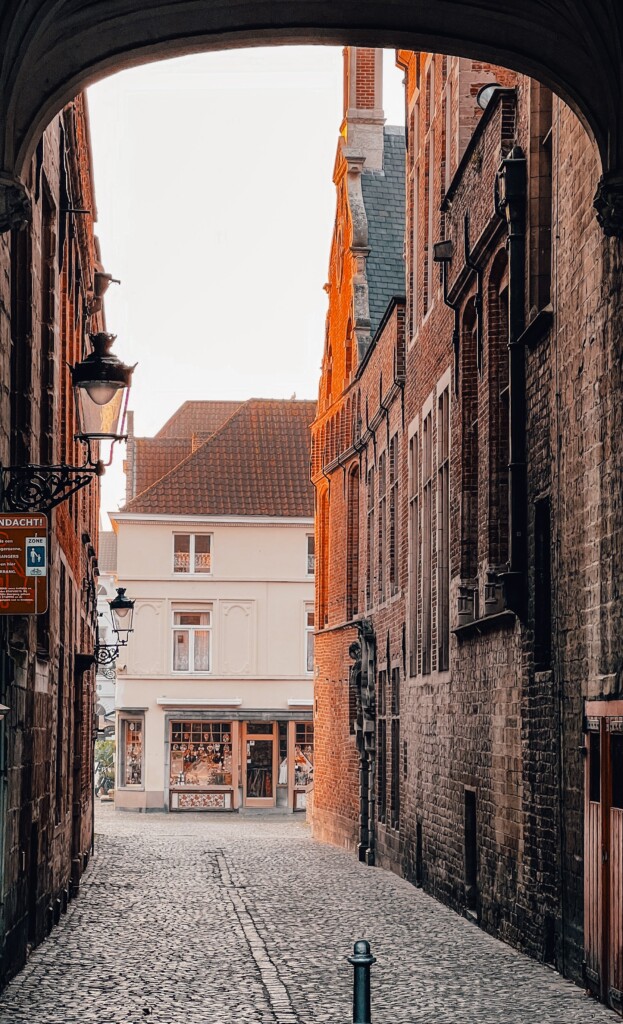
The vault that connects the city hall with the civil registry makes this street more attractive to visitors, which looks very impressive from the outside with gold-colored detailing on its facade.
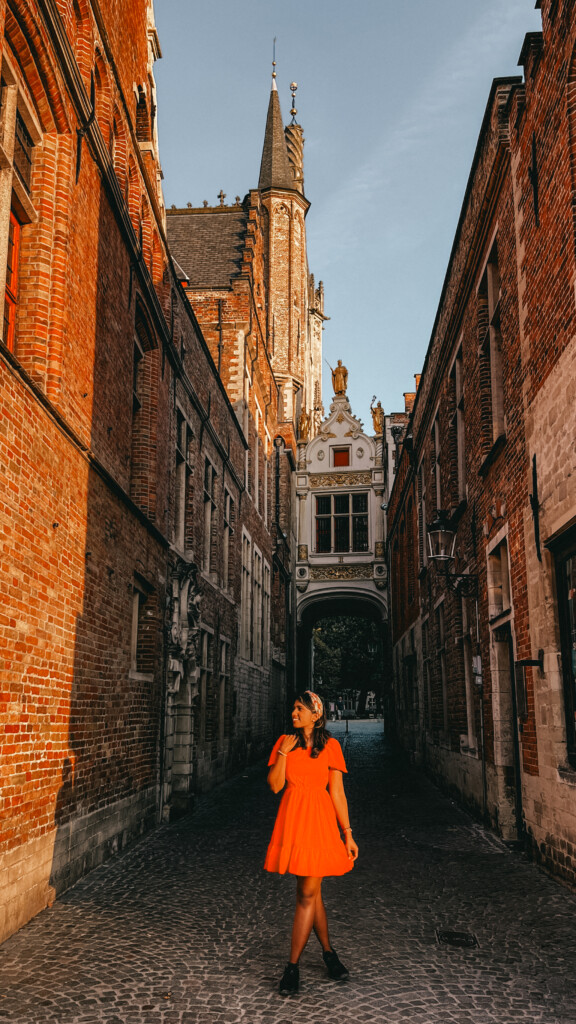
Route Guide
Naturally, the next stop is the square on the other side of the street, which is the length of the street itself, which should be around 100m.
11. De Burg (Burg Square)
De Burg, or the Burg Square, is one of the city’s two significant squares, forming the heart and soul of the historic center. This square is surrounded by various historic buildings built over different centuries, flaunting their charm. It is quite a small square compared to Market Square. However, it holds a lot of significance, history, and beauty.
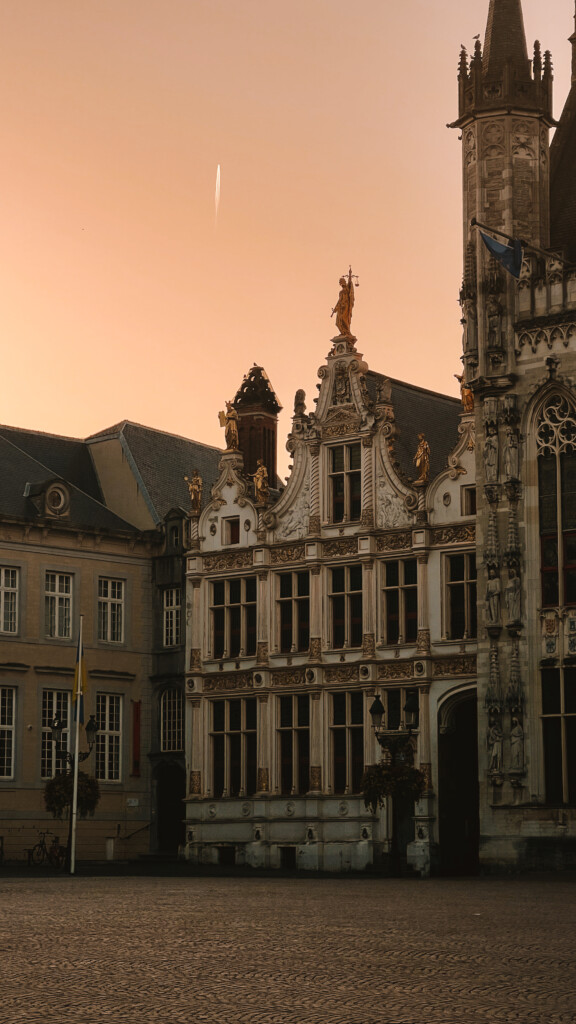
This is where once the power of the city resided; however, even today, it is the home to the 14th-century gothic-style city hall of Bruges (it also has a museum).
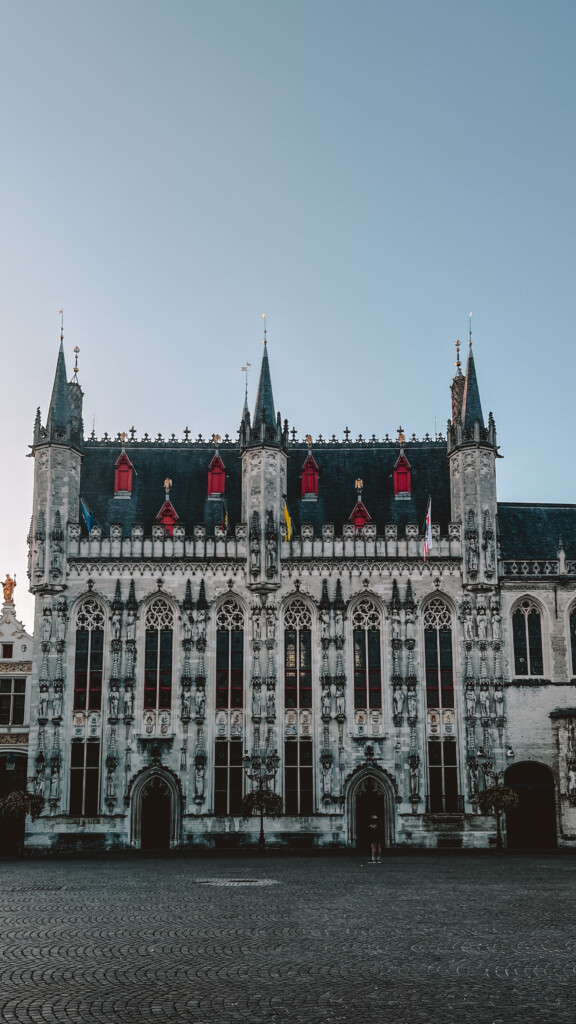
Other Important Buildings in De Burg
Old Courthouse: An 18th-century building that was used as a courthouse. It has an ornate facade with gold-colored details.
Basilica of the Holy Blood (Heilig-Bloedbasiliek): Next to the city hall, tucked in the corner, is a small grey building, which is a 12th-century church that is said to hold a vial of a drop of the blood of the Christ. Hence, the name church of the holy blood.
The church also has a museum with an entry fee, but the chapel is free to visit and worth visiting. Originally, the church was built in Romanesque style but later transformed into Gothic style. (I am no expert and can’t tell much difference between the two styles, but the church’s exterior and interior are impressive.)
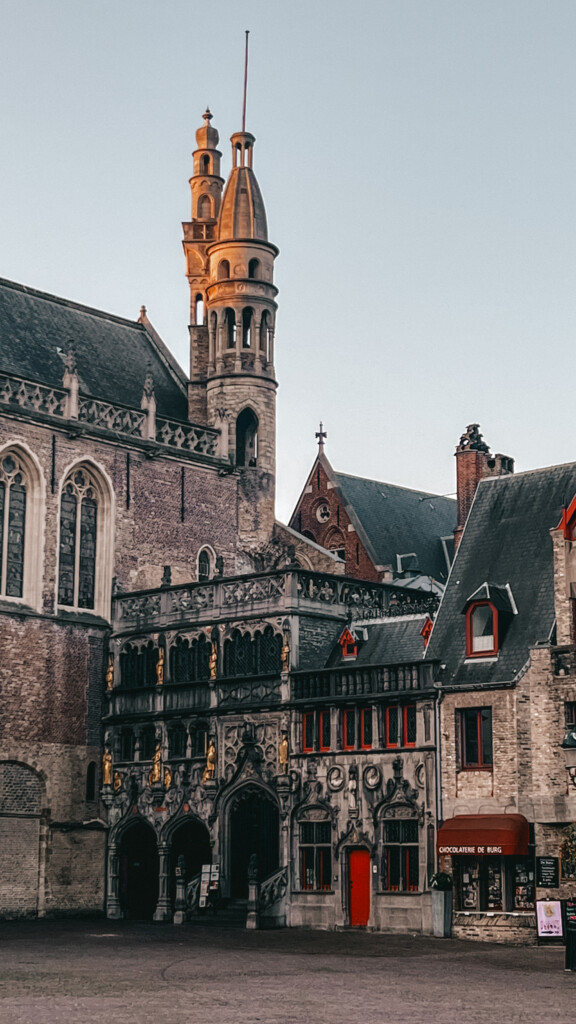
Photo Tip
If you want to click pictures of the square without crowds and cars, visit in the mornings. After 10 am, the square gets filled with many cars parked there.
De Burg gives you some great views of the Belfry of Bruges.
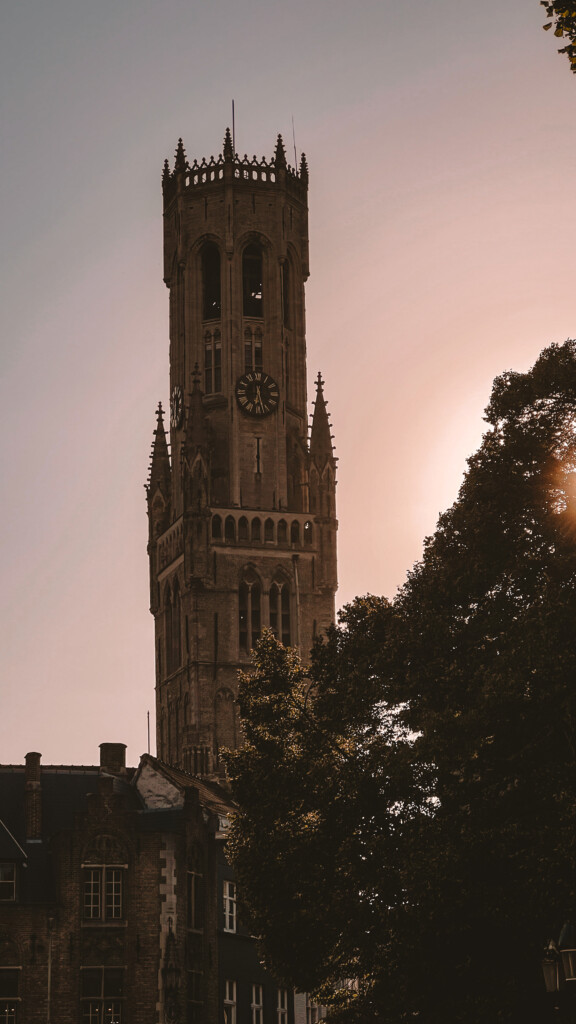
Route Guide
The next stop is just around the corner, about 160 meters from the Burg square. (Hint! It’s the other main square of the city.)
12. Markt (Market Square)
The Markt is, without a surprise, the main square of the city, and the classic postcard image of colorful houses of Bruges that you can see is from here. You can see a row of colorful houses, which are now mostly restaurants primarily aimed at tourists, for you can get an excellent view of the square and the Belfry of Bruges, located just across these restaurants. It is just so beautiful and busy, with the food trucks parked near the entrance of Belfry, the horse carriages waiting to take the tourists for a tour of the city, and many tourists and locals walking around the place.
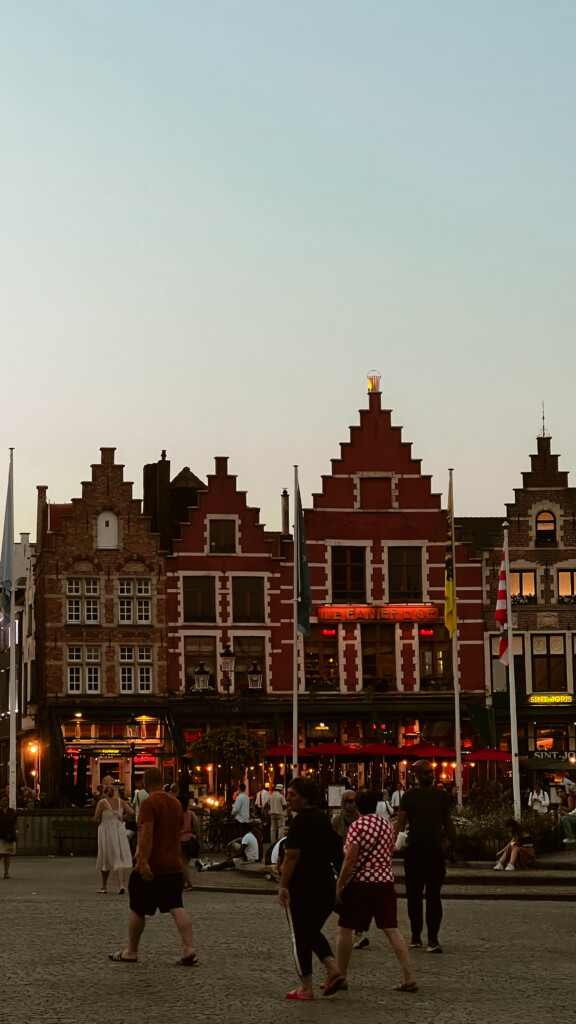
Some other important buildings are located in this square, like the grand gothic-style building, which is the Provincial Court located to the right of Belfry.
The Historium of Bruges is located next to the Provincial Courthouse, which houses a museum and a bar called the Duvelorium Belgian Beer Bar, which offers a good view from its terrace on the first level facing the market square.

At the center of the square, you can find the statue of Jan Breydel and Pieter de Coninck. These two local heroes played an important role in the Flemish resistance, behind which you can spot a series of flags hoisted.
This is by far the city’s busiest area, and I know it’s getting repetitive, but the only chance to see the place empty is early in the morning. But I have to say, unlike others, this place looks lively and more enjoyable when it’s bustling with people than when it’s calm and quiet.
Route Guide
The next stop is right in Market Square, so there is no need to go anywhere.
13. Belfry of Bruges
Belfry is a bell tower in Bruges that dates back to the 13th century. This top of the tower looks like the castle in the chess pieces. It is a protected UNESCO World Heritage site and the city’s most significant tower. It is also one of the first things I think of when someone says “Brugge”. The tower has suffered a lot and undergone multiple renovations, yet it still stands strong.
There is even a poem written by Henry Wadsworth Longfellow called “The Belfry of Bruges”, which goes,
In the market-place of Bruges stands the Belfry old and brown;
Thrice consumed and thrice rebuilded, still it watches o’er the town.
The tower has 366 steps that can be climbed to see a wonderful view of the historic center of Bruges. The view is worth the climb, and you can also stop in between at multiple levels so that you are not completely out of breath by the time you reach the top.
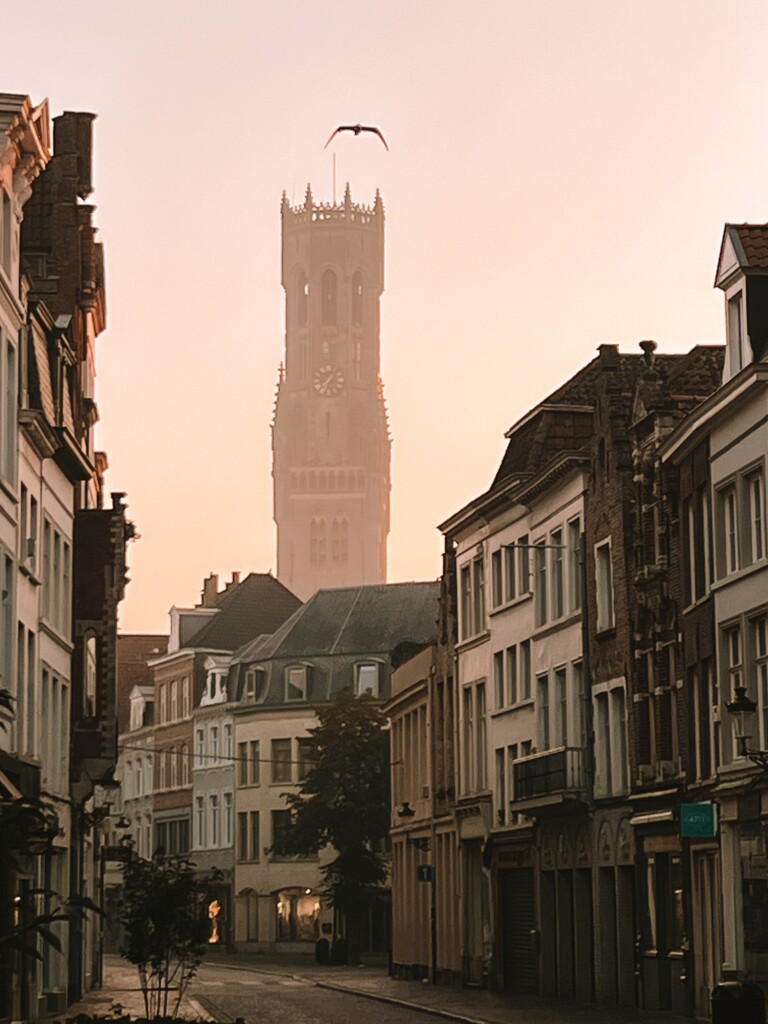
What I love most about Belfries is the 47 carillon bells, which play multiple times during the day. It gives me Christmas vibes even when the sun shines bright in late summer.
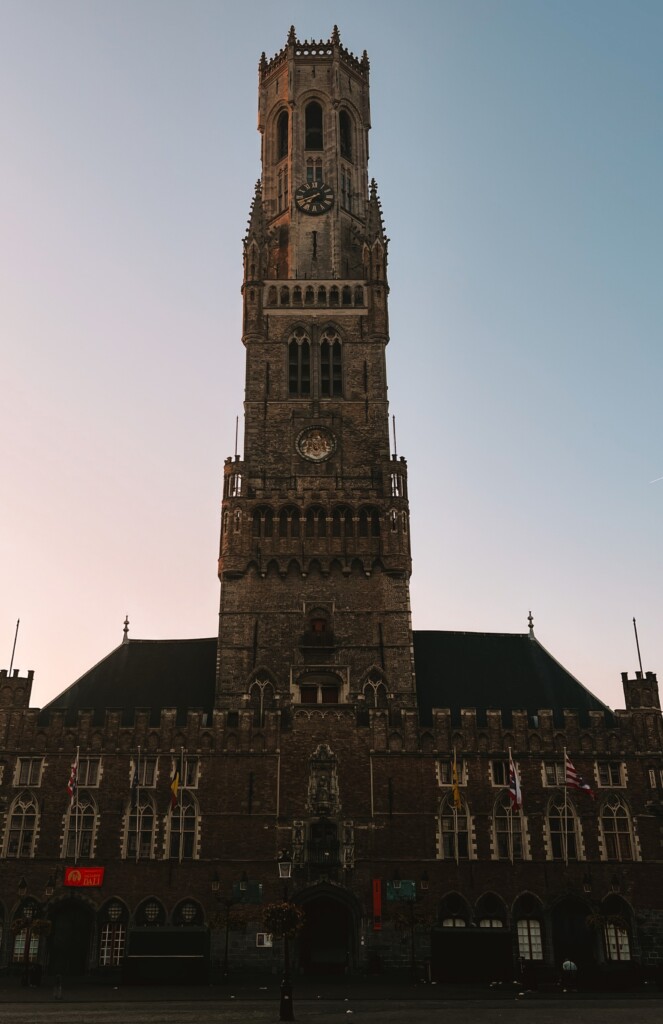
Route Guide
The next stop is a 400-meter walk from the Belfry Tower and should take you around 5 minutes to reach.
14. Jan van Eyckplein
Jan van Eyckplein is a canal-facing square named after the Northern Renaissance painter Jan van Eyck. This place looks lively in the evenings, with people chatting with each other, reading books, or enjoying outdoor meals from the restaurants around. The canal begins right after the statue of Jan van Eyck, who stands tall in the middle of the square.
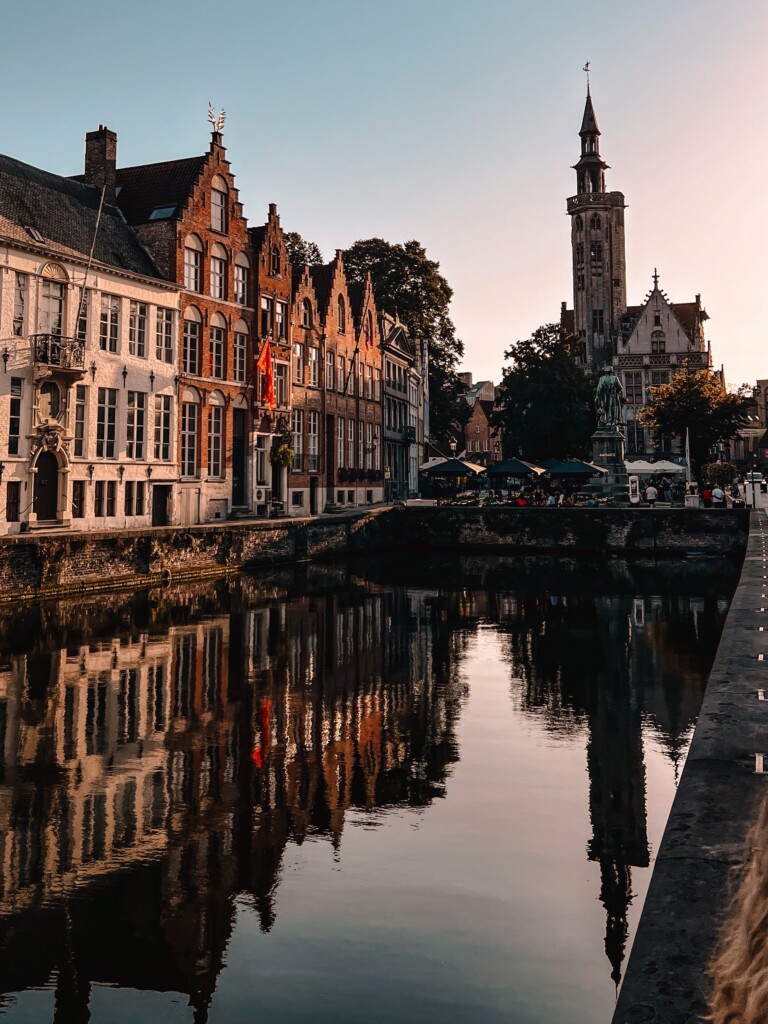
The statue, canal, and the clock tower from a nearby historic building converted to a 4-star hotel (Hotel Biskajer) together offer a stunning backdrop to your photos when taken from Koningsbrug, which means the King’s Bridge (which is the first stone bridge that you spot running across the canal from the square). This is where the boat tour takes a turn and heads back. Also, this canal is called Spiegelrei, where Spiegel means “mirror,” referring to how clear the canal’s water is. On a less windy day, when no boats are around, you can see a clear reflection of the row houses on the canal.
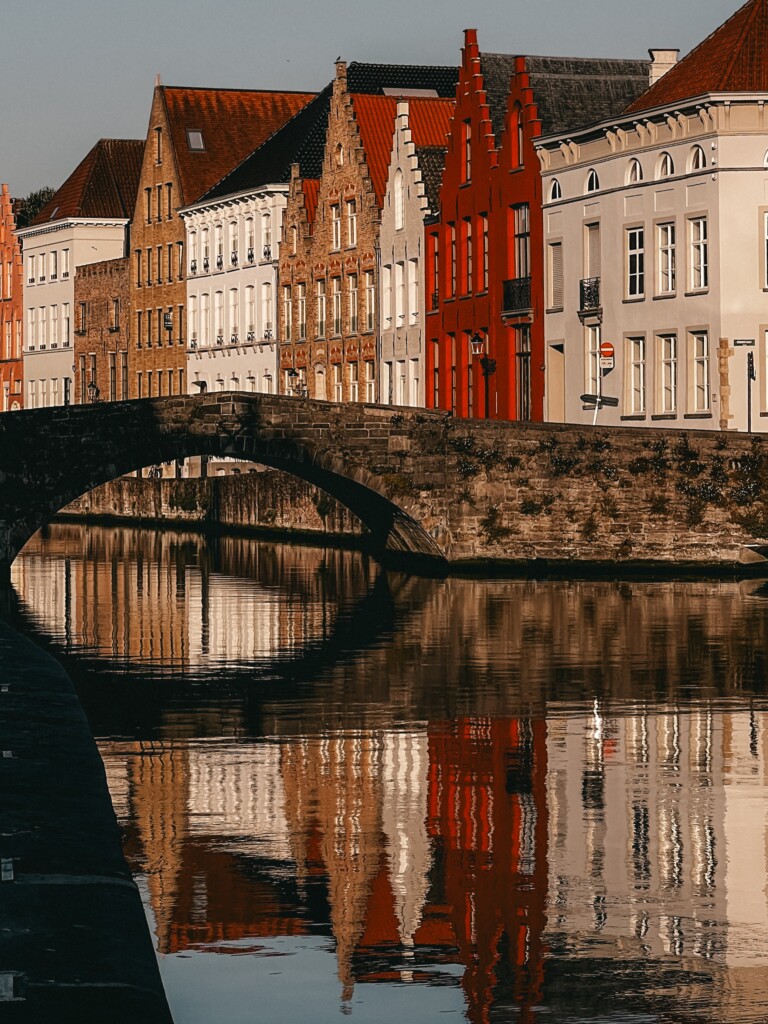
A few blocks from the statue is Genthof 7, which looks like a tarnished house with a wooden facade. Looks quite burnt, but it is one of the authentic medieval wooden houses preserved to date after they were banned in the 17th century as a measure to prevent fire hazards. If you look keenly at the construction, you can see that every level is a little outwards than the previous one. It was a technique used to minimize damage from water logging during medieval times.
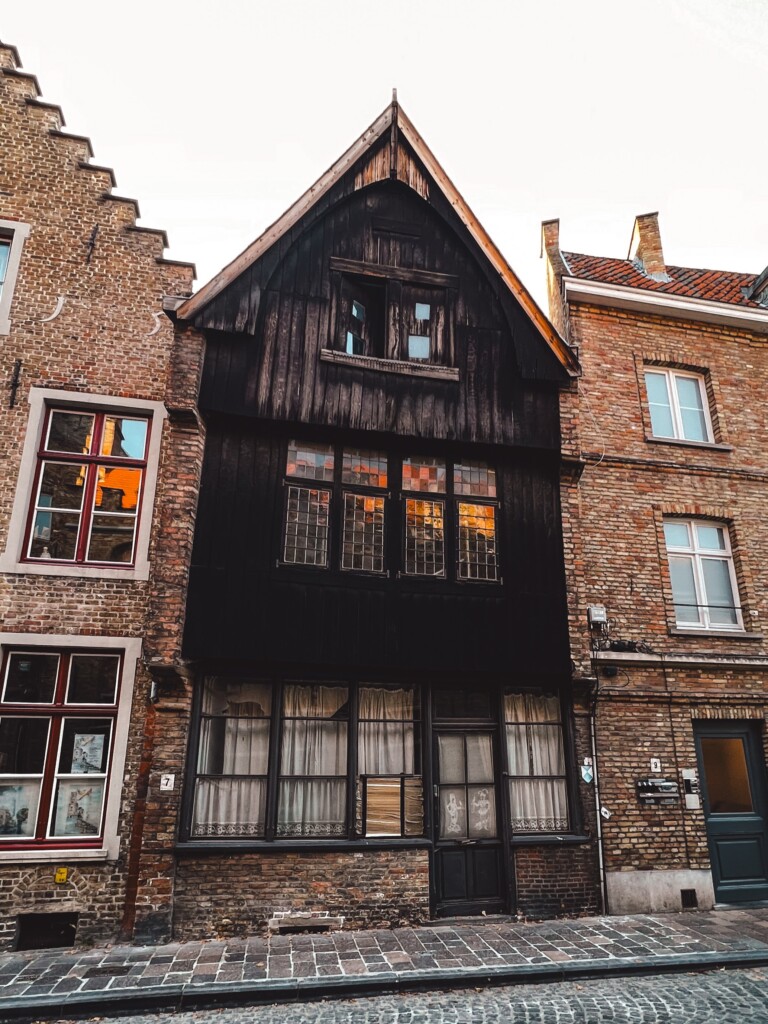
Route Guide
The next stop is 600 meters away from the Jan van Eyckplein. Most part involves walking along the canal of Spiegelrei. Make sure to turn back as you walk along to enjoy the postcard-perfect views of the square.
15. Sint-Annakerk
This church is relatively newer compared to many others in Bruges. This 17th-century gothic-style church has a stunning baroque interior. When the church was initially built, there was a scarcity of materials, making it a single-aisled church. But later, due to the donations of some of the city’s wealthy residents, the interiors were done rather lavishly, which you can see. Hence, it is also called the “Salon church of Bruges”.
Route Guide
The next stop is another 600 meters from the church, and now you are walking a little further away from the crowded center of the city.
16. Kruispoort gate
This is one of the well-preserved city gates of Bruges. This was constructed in the 15th century and is next to the old windmills. If you fancy a longer walk, you can walk along the waters to the next gate, Gentpoort Gate, which is around 1.2 km. Our next stop is in the opposite direction to Gentpoort, so you might want to do a separate walk to cover all four gates at once.
If you are here in the mornings, you can spot a lot of locals taking their dogs for a walk or on their morning jog. It looks very peaceful.
Route Guide
As you might have guessed, the next spot is where the old windmills are. 350 meters from the Kruispoort gate.
17. Sint-Janshuismolen
Although typical of The Netherlands, these types of windmills have also graced Bruges a little after the outer city wall was built. The windmills were reconstructed multiple times in the same location over time, and the one you can see today was not built until 1770. Four original windmills are still preserved as specimens in this region; however, the Sint-Janshuismolen is the only one still operating, mainly used to grind flour. It is also open to visitors. It looks beautiful perched on the slopes with a lush green lawn and water flowing behind it.
Tickets! If you are keen on visiting the inside of the windmill, make sure to get your tickets from the official website.
Route Guide
The next destination is not a single stop but rather a couple of them located next to each other as you walk across the little street. The first one among the many is at a distance of 1 km from the windmill.
18. Bridges of Bruges
By now, it is quite established that the city is full of old and new bridges, most of which are very charming. We will now walk along (across – if you wish to) some of the bridges with picturesque views. If you ask me, “Are these the most beautiful bridges in the city?”. Honestly, I don’t know. Most of them look wonderful, but these are some of the best.
After walking for about 1 km from the Sint-Janshuismolen, you will first reach the Torenbrug. You will walk along the canal Gouden-Handrei (the street is also called Gouden-Handrei).
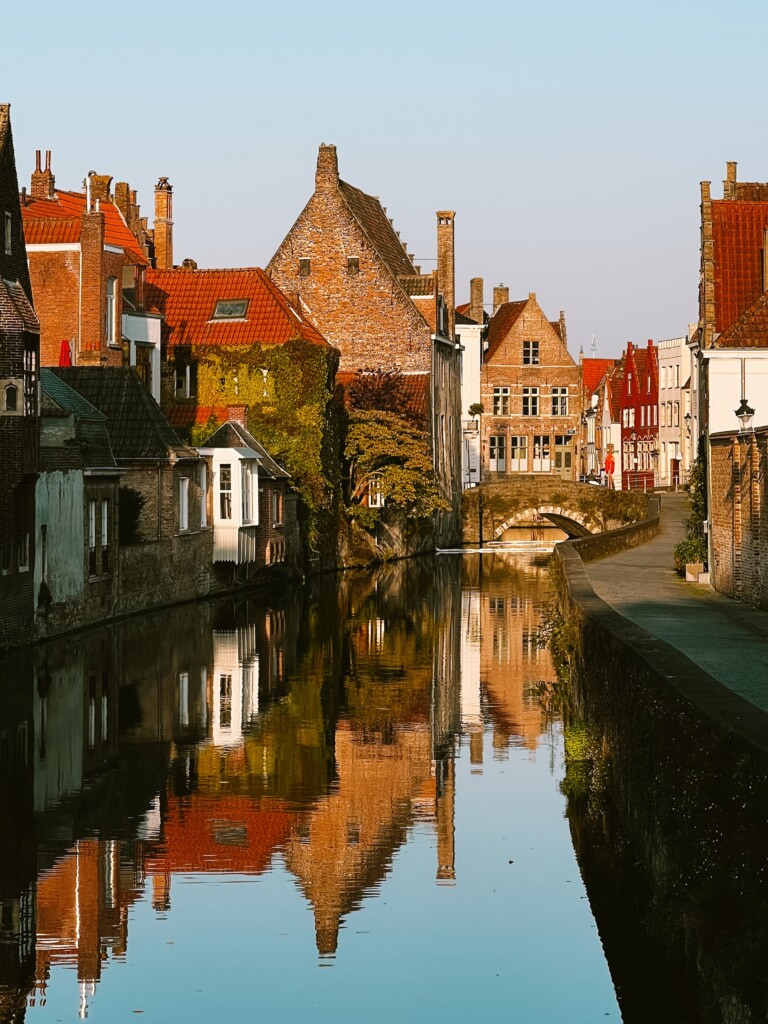
The bridges are from the 14th century, along with the many stone benches you can find along the canal. It is a lovely place to sit, relax, read a book, or enjoy a picnic with beautiful views. This street looks very peaceful and cozy, and since it is a little further from the historic center, you will find fewer people, even during mid-day.
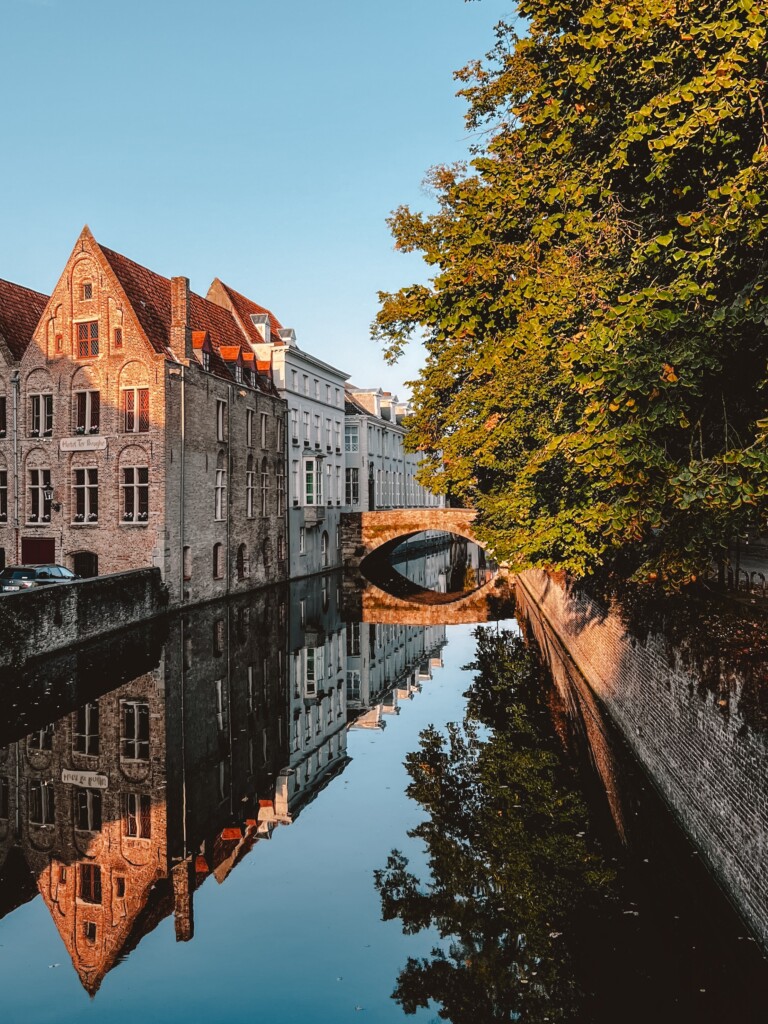
The next bridge along this street is the Augustine Bridge (Augustijnenbrug). From here, you can spot a bridge on either side. One is obviously the Toren Bridge, and the other is the Flemings’ Bridge (Vlamingbrug).
At the Flemings’ Bridge, you must walk across the bridge to continue walking on the other side as it is the only way. The view here is awe-inspiring, especially near Ezelbrug.
Route Guide
The next stop is a 350-meter walk from Ezelbrug. The walk will take you across the same canal, and the route is relatively straightforward.
19. Sint Jakobskerk
Sint Jakobskerk (St James Church) is a 13th-century church that was expanded to its current size by the 15th century. Its huge red doors look majestic on the outside. Over time, the church has collected quite a number of artworks mainly donated by wealthy families.
Route Guide
The next stop is the last, and it is another church, which is quite magnificent. It is around 700 meters from the St James Church.
20. Sint-Salvatorskathedraal
The Sint-Salvatorskathedraal is the oldest parish church of Bruges. This cathedral’s gothic tower adorns the city’s skyline with Belfry Tower and Our Lady’s Church. Saved this destination for the last. Finishing off the walking tour in style, don’t you think?
This massive cathedral was built in the 12th century as just a Parish church. The construction of a new, bigger church began after the demolition of the Sint-Donaaskathedraal, which was once near the present city hall, due to a fire.
After the construction, which lasted over a century, the Sint-Salvatorskathedraal slowly reached its current size and grandeur. The church eventually attained its status as a cathedral in the 19th century. Throughout this period and to date, the church has gone through multiple renovations. Yet, it still stands tall, marking the skyline of Bruges.
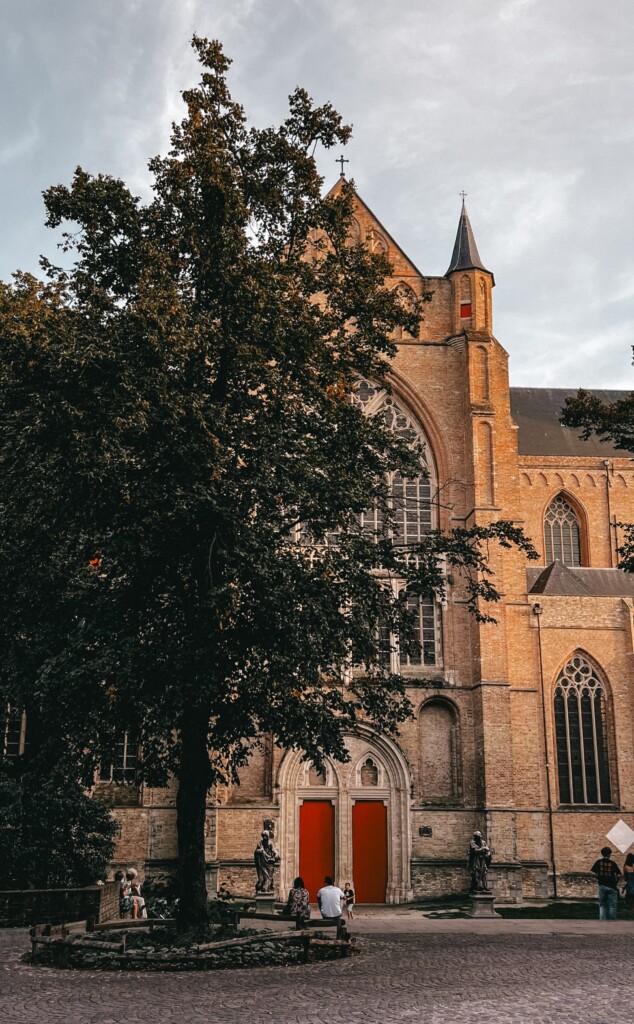
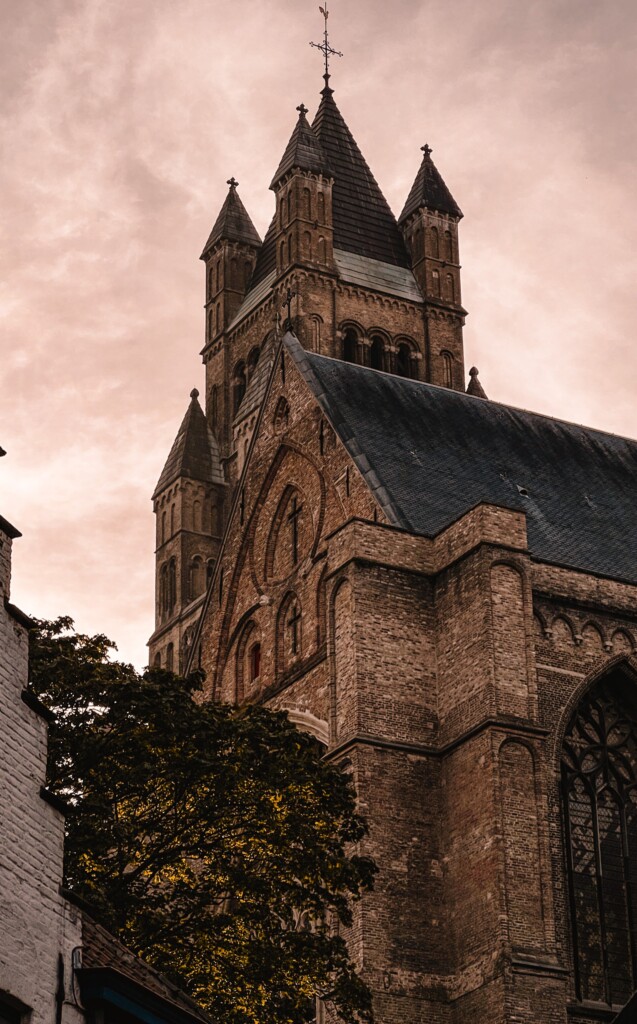
Route Guide
This is the end of our walking tour, and the next stop is the station from where we started. The walk back to the station is around 1.1 Km.
Oh, wait! While heading back to the station, take the route that goes through ‘t Zand Square, especially if you are visiting on the first half of Saturday when there is usually a market here with various shops filling the otherwise empty square. You can find food, clothing, and various other items in the market here. I always enjoy shopping here and love the atmosphere in general.
Where to Stay in Bruges?
Staying in one of the medieval houses converted into B&Bs and hotels is definitely a must. There are so many beautiful stay options in Bruges. Book yours well beforehand, as most good ones get booked quickly.
Luxury
Mid-Range
- De Zomere B&B
- Boutiquehotel ‘t Fraeyhuis
- Dukes’ Palace Brugge
- Dukes’ Academie Brugge
- Maison Amodio B&B
- Guesthouse Maison de la Rose
Budget
Want to explore more options in Bruges? Please search on Booking.com here. We use Booking.com to book all our stays and have always had a good experience.
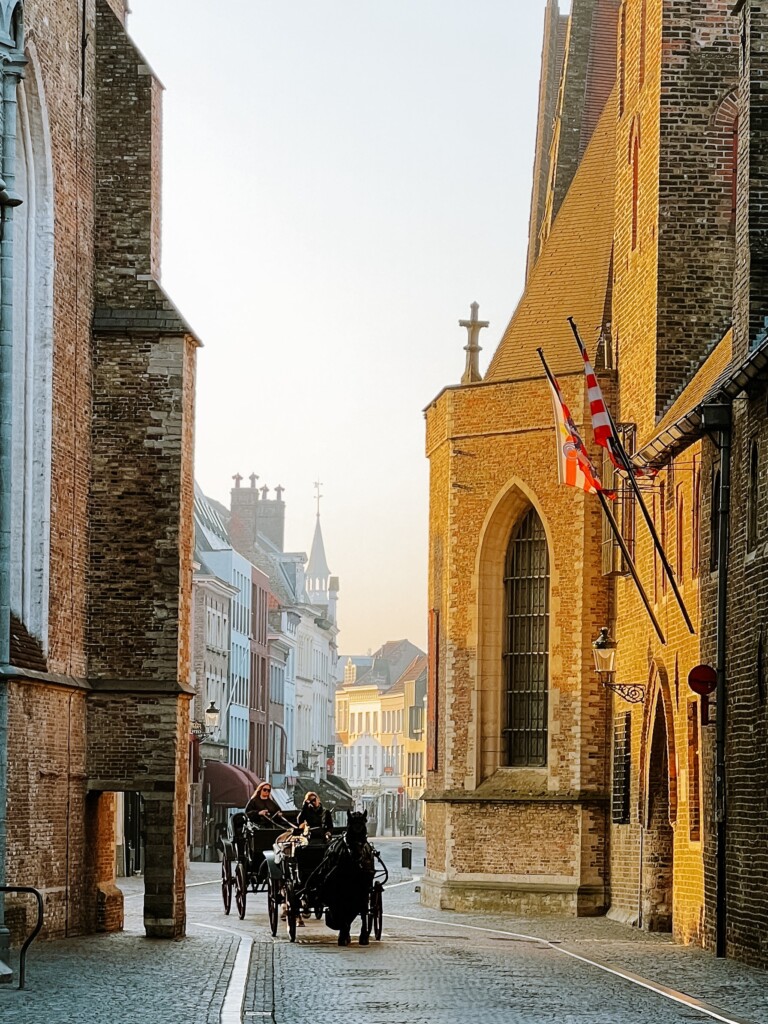
Now, you have everything you need to know to go on a self-guided walking tour of the city. Take your time, soak in the magic, take tons of pictures, and enjoy a lot of delicious food on the way. (We can burn the calories with more walking.)
Are you excited to visit Bruges? I visited Bruges twice in the fall, so I have compiled some amazing and adorable things you can do in Bruges during the fall season. Also, don’t forget to read about the important things to pack for a fall season trip and some useful information to know before you visit Bruges.
If you are visiting Bruges, add the nearby city of Ghent to your itinerary. If you are not convinced, I have enough photos of this beautiful city to tempt you to visit it.

